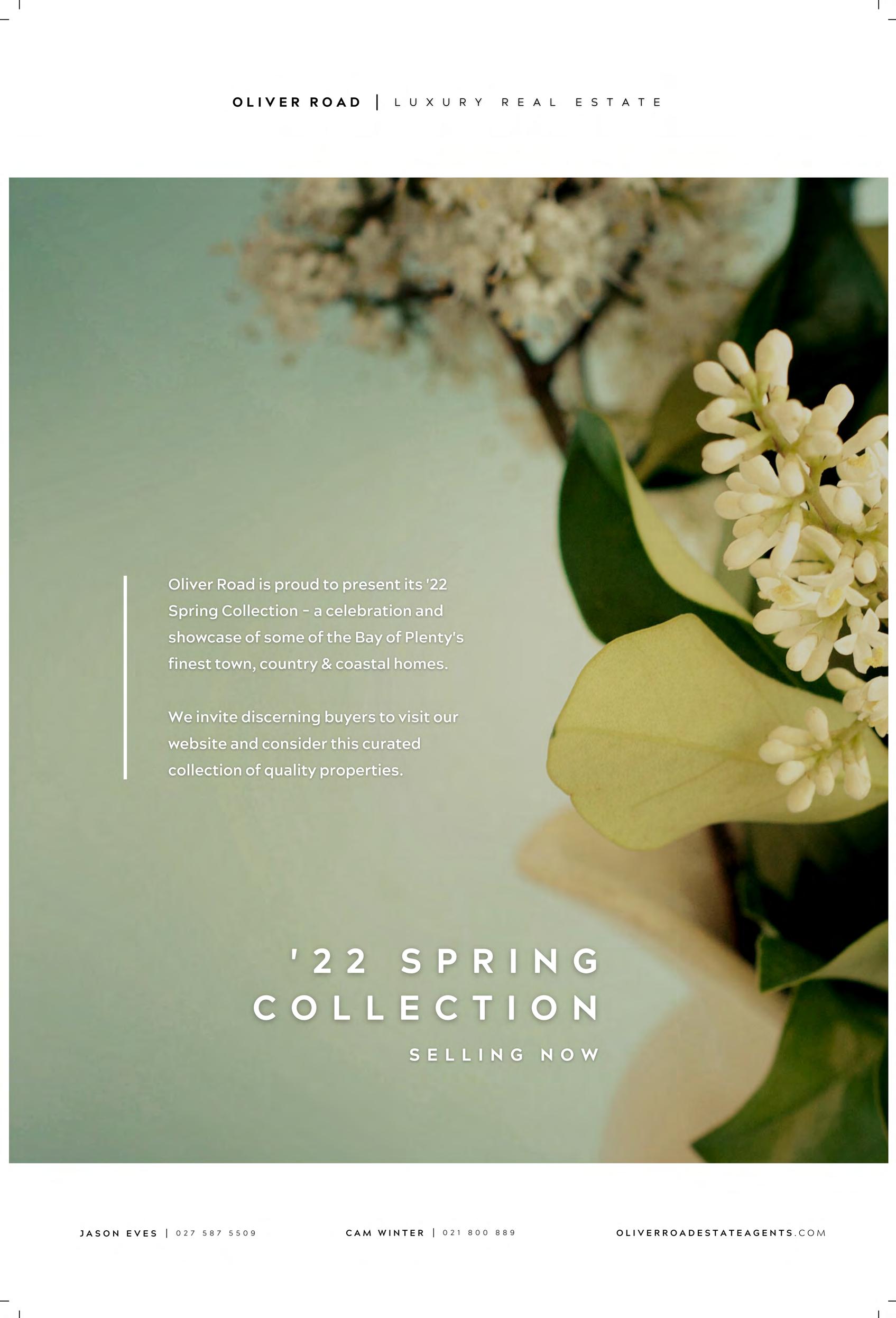

TNL PREPPING FOR BUSY CONSTRUCTION SEASON

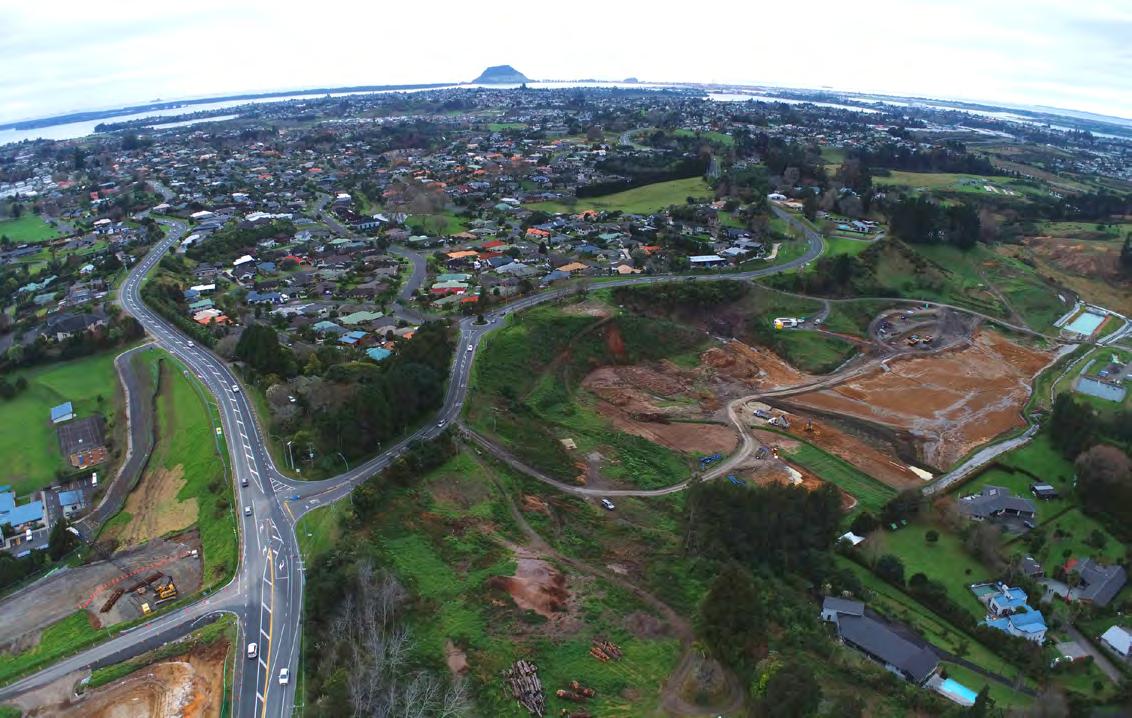
TBy RICHARD RENNIE
auranga’s twin geographical challenges of slope and swamp have not impeded a rapid start to the district’s longest awaited roading project, the Takitimu North Link (TNL).
The 6.8km long project linking Takitimu Drive toll road through to Loop Road at Te Puna has long been an on-again, off-again affair for over 15 years as traffic volumes have ballooned on State Highway 2.
But Waka Kotahi regional manager for infrastructure deliver Jo Wilton says since commencing earlier this year, significant preparatory site work has been completed ahead of the busy summer earthmoving season.
“There has been a lot of initial groundwork undertaken to prepare and open up the site for commencing the project itself.”
This includes constructing haul roads and commencing a staging bridge on the Wairoa River site for construction vehicle crossings. Wairoa road has been re-aligned and sediment trapping ponds installed while extensive archaeological investigations have also been completed.
The coming season will see over 400,000 cubic metres of dirt being moved between cut and fill locations around the project, while over 3.0 million cumec will be moved through the project’s entire five-year lifespan.
“Other work underway includes the recent commencement of the Cambridge Road overbridge, due to be completed by late 2023,” she says.
Turn to page 3

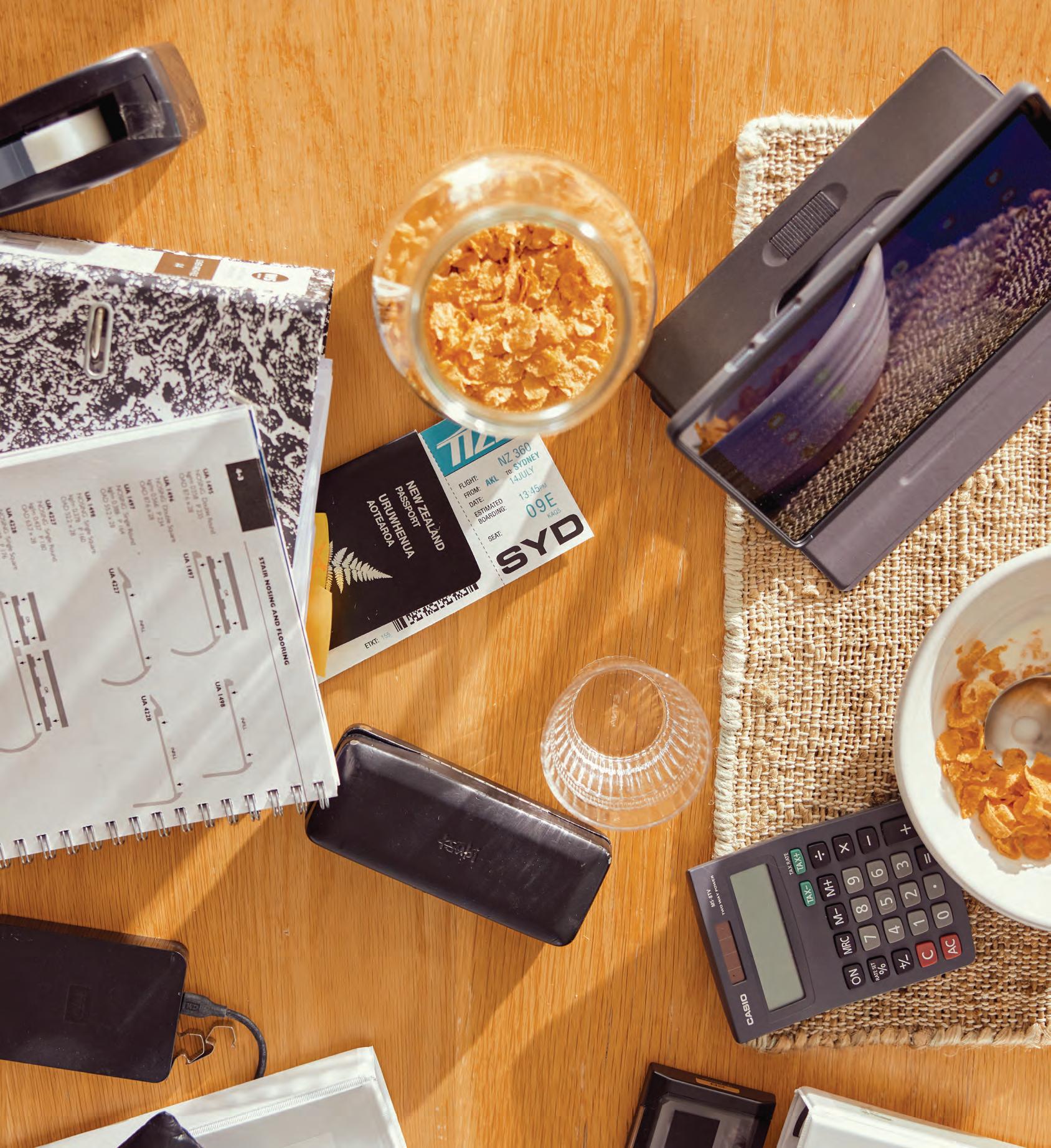

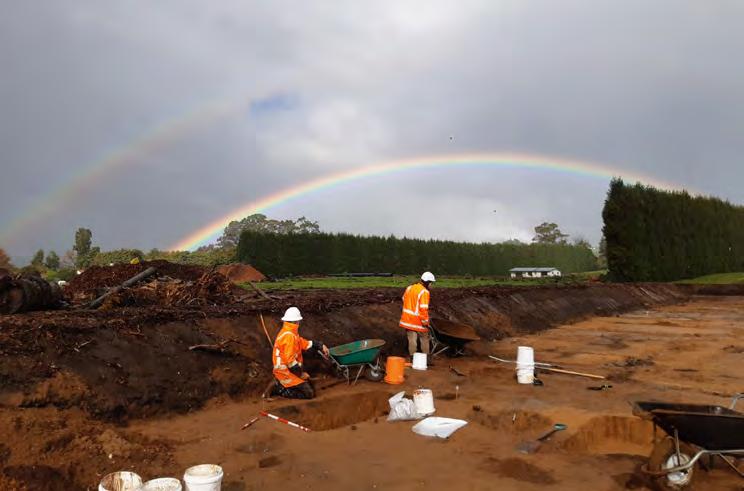
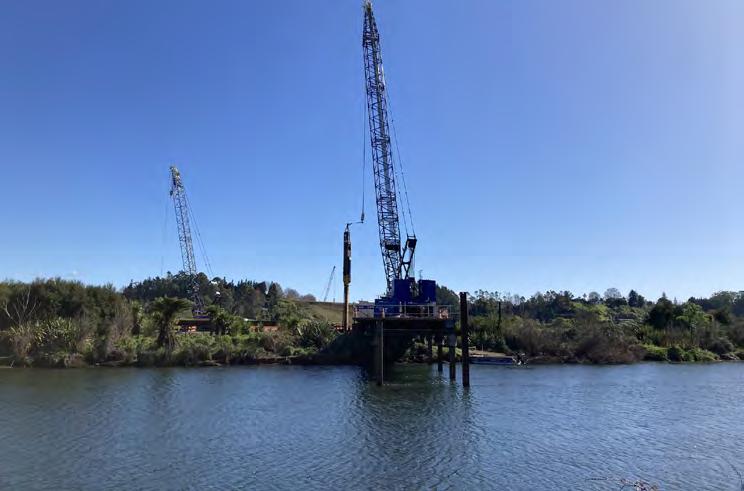
TNL PREPPING FOR BUSY SEASON
With its multiple gullies and ridges, the project brings its own challenges, with timing between cutting through ridges and depositing fill on swamp and flat areas being critical.
The new Wairoa River bridge crossing and valley worksite is only one of eight bridges within the project, but by far the largest, at 347m long. Given the bridge’s swampy, flat approach on the Wairoa valley floor, extensive wick drainage has been installed to manage the water table. Meantime extensive bunding and pond construction to prevent silt and dirt run-off into the river has proven effective over the very wet winter period.
The Cambridge Road overbridge will be constructed using a top-down method, with the bridge built on current ground and excavated beneath it for the new road.
Wilton says a key focus for project operators has been securing supplies and equipment well
in advance, ensuring continuity of construction at a period when materials can have long lead times for delivery, even from within New Zealand. She said at this stage the decision on whether the link would be a tolled road or not had not been made. Normally when a new state highway is built Waka Kotahi carried out an assessment to see if it meets the criteria to be tolled, as will be done with TNL.
A tolling assessment is expected to be completed this year, and if considered a feasible option, will be consulted on with public next year.
A key consideration is how a tolled road would fit in with the wider transport network, and with TNL that includes the fact Takitimu Drive already has a toll road, and whether tolling across both would be feasible or desirable.
The $655 million project is funded under the New Zealand Upgrade Programme, a $12 billion fund announced in early 2020 with road,




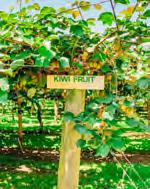


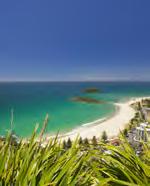
rail, schools, and hospitals all part of plans to boost infrastructure by $10 billion over five years.
The 6.8km TNL project is however only part of a larger project that has been significantly curtailed.
Construction of stage 2 of the link, from Te Puna to Omokoroa was cancelled until at least the next decade by government a year ago, a victim of covid inflicted debt levels.
The 7km route will be protected for future work, but construction would require funding through the National Land Transport Programme, and government officials said it was unlikely within the next 10 years.
Traffic volumes on the Omokoroa-Tauranga portion of state highway 2 have grown significantly in recent years with housing development in the district, with volumes of 20,000 vehicles a day equalling the Waikato Expressway’s numbers.
In
Takitimu Northern Link project
• 6.8km long four lane corridor
• Separated walking and cycling path
• $655 million
• Opening late 2026
• New Wairoa River bridge crossing
• Overbridge interchange at Minden Rd
• Underpasses at Cambridge and Wairoa Roads
• New westbound lane connection from 15th Ave to Takitimu toll road
its current state it has been rated as one of the country’s highest risk rural roads. Wilton confirmed traffic volumes were expected to grow to over 30,000 a day along the state highway route over the next decade.
From page 1
Archaeologists and Kaitiaki work under a rainbow – June 2022.
Wairoa River temporary construction bridge building
www.bopbusinessnews.co.nz
CONTACT INFORMATION
PUBLISHER
Alan Neben, Ph: 021 733 536
Email: alan@bopbusinessnews.co.nz
EDITORIAL
Alan Neben, Ph: 021 733 5366
Email: editor@bopbusinessnews.co.nz
PRODUCTION – Copy/Proofs/Graphic Design
Times Media – Clare McGillivray
Email: clare@times.co.nz
ADVERTISING
Pete Wales, Mob: 022 495 9248
Email: pete@bopbusinessnews.co.nz
ELECTRONIC FORWARDING
EDITORIAL: News releases/Photos/Letters: editor@bopbusinessnews.co.nz
GENERAL INQUIRIES: info@bopbusinessnews.co.nz
Bay of Plenty Business News has a circulation of 8000, distributed throughout Bay of Plenty between Waihi and Opotiki including Rotorua and Taupo, and to a subscription base. www.bopbusinessnews.co.nz
Bay of Plenty Business Publications
309/424 Maunganui Rd, Mt Maunganui, 3116
Bay of Plenty Business Publications specialises in business publishing, advertising, design, print and electronic media services.
THE PORTER REPORT
When mergers falter
The government’s ambitious attempt to merge the country’s major polytechnics into one national grouping allegedly has been faltering and has become the subject of a series of damning criticisms in the media by some of those familiar with the process.
The latest blow was the announcement that the appointed chief executive Steven Town – who had been absent on special leave for some time – had resigned. At the time of writing, little had emerged as to the reasons for his departure.
Board chairperson Murray Strong in a note to staff of the Hamilton-headquartered national organisation thanked Town for his contribution to the proposed institution. Board member Peter Winder will continue as the acting chief executive for now.
Based at the current Wintec campus in Hamilton, the new institution, named Te Pūkenga, involves the proposed merger of the country’s 16 institutes of technology and polytechnics and four Industry Training Organisations into one entity.
Hipkins and his spokesperson have dodged any significant comment on the subject, or on reports that the merger is already more than $100 million over its proposed budget.
Approached for comment, a spokesman for Hipkins said: “It’s not appropriate for the minister to be drawn into employment matters in any way.”
Some critics have called for the appointment of a special commissioner to examine what went wrong in the process.
polytechnic Toi Ohomai. I first encountered Fourie when I profiled him soon after his arrival here from overseas.
Fourie quickly became a presence in the region’s business and academic forums and is an effective public speaker.
Local polys are ‘early movers’

munities will still receive the same great education and support, but the opportunities for ākonga (students) and employers will be much greater.”

In case you missed last month’s edition Scan to subscribe

However, a leaked and very critical memo from Tertiary Education Commission deputy chief executive Gillian Dudgeon to Education Minister Chris Hipkins painted a damning picture of an alleged lack of progress of the proposed amalgamation.
Dudgeon’s memo to Hipkins – dated May, but recently published on the commission’s website – says the organisation’s financial situation was a “significant concern” and was predominantly due to lower provider-based enrolments. These enrolments were down by 12 percent on the previous year.
“This decline is in strong contrast to Te Pūkenga’s 2022 budget, which assumed a four percent increase in enrolments.”
I reached out for comment to Leon Fourie, who is the chief executive for local
Fourie said that Toi Ohomai and Wintec (Hamilton) were “early movers” who were deemed change-ready and officially joined Te Pūkenga on June 1, ahead of other polytechnics.
The rest of the polytechnics will move across into Te Pūkenga by the end of October this year, he said, and all Toi Ohomai campuses across the Bay of Plenty and South Waikato were now officially part of Te Pūkenga.
“This means our leadership is aligned, but our daily operations have continued with no change,” he said.
He told Bay of Plenty Business News: “You will still work with the same great people, and our learners and com-
There continued to be lots of work underway to ensure the success of Te Pūkenga and that of kaimahi (staff) and ākonga, he said, noting that Te Pūkenga had begun engagement with kaimahi around the country about the proposed organisation and leadership structure and regional delivery framework.
“I am very confident in the work that is underway to ensure the success of Te Pūkenga and firmly believe in the positive outcomes for our ākonga,” he said.
“Te Pūkenga is bringing together on-the-job, on campus, and online vocational education and training through a unified, sustainable network.”

David Porter

LOCAL GOVERNMENT
Commercial waste volumes to be analysed
By ANNE TOLLEY, Tauranga Commission Chair
The volume of commer-
cial waste sent to landfill by Tauranga businesses will be analysed as part of the city’s Waste Management and Minimisation Plan, so that we can compare our performance with other major centres.
By early next year, we expect to have some reliable data on what the sector is currently ‘dumping’, so that we can understand the scale of our commercial waste issues and work together to reduce landfill volumes by re-using and recycling as much waste as possible.
As it stands, commercial waste probably makes-up at least 75% of the city’s waste stream and if that is the case, there’s clearly an opportunity to make a big difference in the volumes we currently send to landfill.
We’ve seen just how much can be achieved in waste reduction through our household kerbside waste collection system, which has only been operating for around 14 months. Despite being heavily impacted by Covid-related illness and lockdowns, the volume of household waste sent to landfill has nearly halved to around 111kgs per person a year.

That means we need about 460 less truck journeys over the Kaimai Ranges each year to take the waste to the landfill at Hampton Downs, and less carbon emissions as a result, but Tauranga’s environmental footprint also benefits because we’re now composting most of our household food waste and a substantial volume of greenwaste, both of which contribute to landfill methane emissions.
And of course, we’re recycling a lot more plastics, cardboard and paper, cans and glass than we used to as well, which also enhances the city’s sustainability.
Once we have a clear idea about what our commercial waste is comprised of and what volumes of the various components are being produced each year, we will be able to start thinking about how much we could expect to
take out of the waste-stream and what sort of collection and processing operations would be needed to make that work.
Council’s Sustainability and Waste team will be engaging with commercial stakeholders to discuss both the issues identified and the opportunities available to us.
As was the case with our household collection service, we would anticipate that an effective approach to commercial waste handling and processing could offer financial benefits, as well as environmental gains.
Most households now pay substantially less for their waste collection than they used to under a fragmented and inefficient private collection service model, as a result of the economies of scale our new system provides and the ability to compile commercial volumes of recyclable material.
We’re looking forward to working with the commercial and industrial sectors to explore ways we can all benefit from a more efficient and effective waste disposal approach.
If you have any ideas you think should be considered, please pass these on to our Sustainability and Waste team via sustainability. waste@tauranga.govt.nz.
Eight is the lucky number for creative agency
The creative team at WOODS Agency have been named as finalists for an unprecedented eight entries across five categories at the Best Design Awards 2022.
The awards, presented by the Designers Institute of New Zealand, recognise the best creative work produced throughout Aotearoa and Australia in the past 12 months.
Based in Mount Maunganui and Tairāwhiti Gisborne, WOODS Agency is the only regional agency to place as a finalist.
Founder and Managing Director, Reuben Woods, says the team is delighted to be shortlisted for many award categories during what has been a challenging year for the economy.
“Entering these awards was important for our team and our clients. We know that we create world-class strategies and creative, and the results for our clients have been outstanding. This is a testament to our teams’ talent and the willingness of the businesses we work with. It also shows how successful the business environment is in the regions,” he says.
“Key to this success is our open and collaborative relationships with our awesome clients. This established trust allows the team to push the boundaries and create outstanding creative with real impact,” says Woods.
WOODS Agency specialises in partnering with brands driving meaningful social and behavioural change in Aotearoa.
“The organisations that we’ve worked with on the projects in the finals are purpose and impact driven, these are the brands and the people that we love to work alongside. They share our aims to take action around culture, community, people, well-being and sustainability. We’re setting out to use our creativity to be
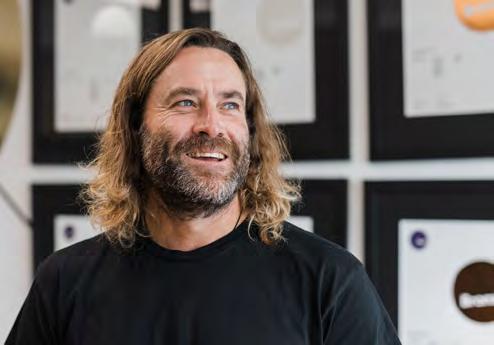
a catalyst for good,
Some of the clients included in the awards entries this year include the Western Bay of Plenty District Council whose colourful rebrand by WOODS, the first in 30 years for the organisation, is a finalist in the Large Brand Identity and the Colour Award Graphics categories. The team created an inspirational, timeless brand which reimagined the Kiwiana concepts central to the WBOPDC’s original look while adding a human feel to link the organisation to the community.
Woods is particularly proud of the work the team put into branding for the Young Innovator Award (YIA), a finalist for both the Small Brand Identity and the Public Good Award.
“YIA is close to our hearts. We co-founded the programme 12 years ago to foster a culture of innovation amongst rangatahi in our region and remain major sponsors of the annual event.
“We were excited to have the chance to rebrand YIA for the first time since its inception. We wanted to reflect both the changing world our rangatahi are living in and the opportunities these changes create to
express themselves through innovation,” says Woods.
“It’s the icing on the cake to be placed in the finals for this type of mahi, and this means so much to our whole team.”
The WOODS team will have to wait until early October when the Best Awards are presented to find out if their eight finals placings evolve into category wins.
“Placing as the only finalists outside of the main centres is a huge honour. We’d love to take the win too – but we’re just excited for our clients to see their brands come out on top of so many others throughout the country,” says Woods.
WOODS are finalists for their work in the following categories:
• Western Bay of Plenty District Council: Finalist Large Brand Identity & Colour Award Graphics Ōtūmoetai College: Finalist Large Brand Identity & Colour Award Graphics
• Young Innovator Awards: Finalist Small Brand Identity & Public Good Award
• Pāpāmoa
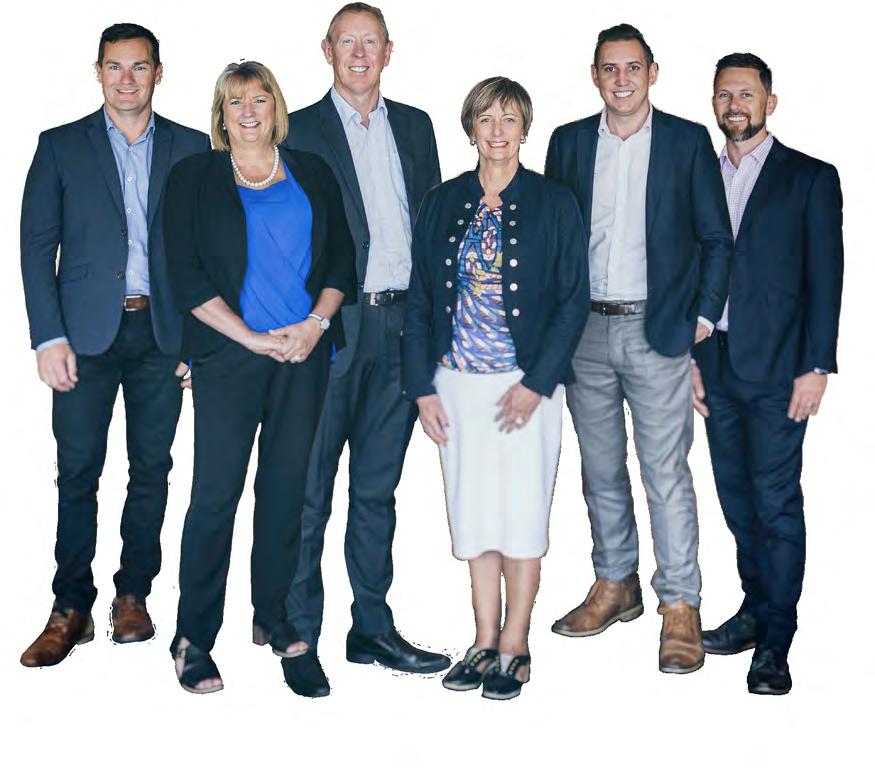
to build a better future for whānau and whenua,” says Woods.
Reuben Woods
AnneTolley
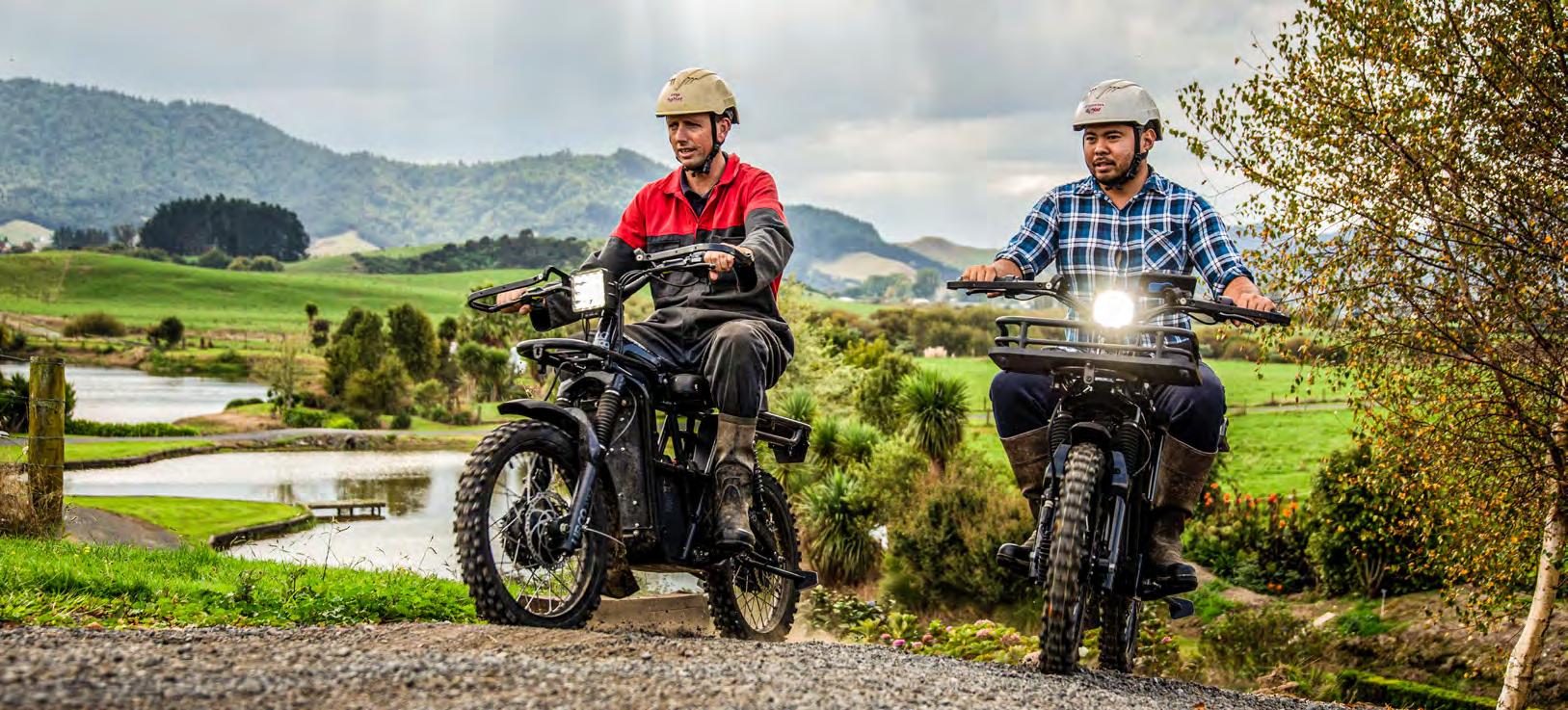
UBCO WINS NATIONAL HIGH-TECH AWARD
Tauranga-based electric adventure vehicle company UBCO was recently named the Pacific Edge Hi-Tech Emerging Company of the Year at the 2022 NZ Hi-Tech Awards.
By DAVID PORTER
The Award recognises the growth and impact to date of the UBCO electric bike, along with the future global potential of its hardware and software platform. It was presented in front of a record 1100 crowd of New Zealand’s top tech talent, alongside the other outstanding finalists in this category including NanoLayr, Auror, Lumin, MacroActive and Tauranga’s LawVu.
“We are thrilled and couldn’t be prouder of the UBCO team, and our supporters,” said UBCO’s executive chair and CEO, Katherine Sandford.
Back in April 2018 the startup featured on Bay of Plenty Business News’ front page. The company’s then CEO, Timothy Allan talked about UBCO’s success at the time in securing funding to launch its electric utility bike into the American market (Allan was speaking then at the Innovation is Gold seminar in Tauranga, one of several hosted around New Zealand at the time by IP law firm James & Wells).
Rise from humble roots
UBCO has risen from humble roots in a Wairarapa shed and has achieved almost 3X year-onyear global revenue growth. The company now addresses a gap at the intersection of the US$50 billion powersports market and the fast-growing adventure market, worth an estimated US$800 billion in the US alone.
Sandford told Bay of Plenty Business News that the idea was born from its early roots in farming.
“We remain committed to that sector, and it’s a great testing ground, particularly in New Zealand, to ensure our products continue to be tough enough to deal with any environment in any geography,” she said.
“But focusing on the adventure market for explosive sales growth allows us to take advantage of the multi-billion-dollar powersports sector in Northern America. There’s a fast-growing hunger for outdoor recreation and exploration activities.
“There’s a fast-growing hunger for outdoor recreation and exploration activities, and we

have had such high demand for our newest models that we’re expecting more than 3x revenue growth again this year.
“They’re using UBCOs for everything from conservation in Africa and tourism in Rarotonga, to off road exploration in the US and urban food delivery here in New Zealand. There’s even Art Mathias who straps our 2X2 to his plane to explore the Alaskan wilderness.
“Much of this success is built on what we learnt from our original Kiwi users – many of them farmers who took a risk on an unusual product by a small startup.”
What the judges liked
For the Award, the judges were looking for
a winner that had made the transition from a startup, revenue-wise, that had an exciting story of innovation, market opportunity, competitive advantage and plans to achieve the goals it sets, and that could demonstrate significant revenue growth, while having a clearly articulated business strategy.
The judges said, “New Zealand now has a globally focused motorcycle company, and the product is green, fun to ride and targeting a growing market niche. Fantastic.”
Sandford told Bay of Plenty Business News the company was still seeing demand from other markets, but they were keeping their eyes on North America for initial growth, opening up Canada as an extension of the massive US market.
“In the US, we have signed a recent deal with Tucker Powersports who have around 6000 dealerships, providing UBCO with an extra 75 sales reps on the ground across the country,” she said.
“In addition, we’re firing up our US direct-toconsumer (DTC) engine and are seeing steady growth from that channel as well. UBCO is also currently in the midst of a funding round seeking a minimum of US$5 million from wholesale investors.”
The new round would then be matched by an undisclosed existing investor.
Growth across key markets
“Currently, at UBCO, we are taking the company to almost 4,000 units sold to date across our key markets,” she said. “There’s a fast-growing hunger for outdoor recreation and exploration activities, and we have had such high demand for our newest models.”
And the upsurge in demand for electric vehicles was growing as the products become better and more suited to the mainstream market, she said.
“Kiwis have always been great adopters of more sustainable practices and switching to electric is one aspect that is just continuing to grow.”
China was initially, and continued to be, a key supplier of components and products, but Sandford told Bay of Plenty Business News that UBCO had secured supply chain and production agreements with Taiwanese-based powerhouse, TPK.
“For the US market, we actually produce the 2X2 in Oregon. That enables us to be able to label the product as, “Designed in NZ, made in USA” – which is seen as a real positive by our customers there.”
Covid 19 had a major impact on manufacturing supply chains globally, but Sandford said the company currently had a very healthy supply chain that was keeping up with the company’s high demand and growth.
“UBCO is currently delivering on average within five days of order to customers in the US, so for now, we have a massive competitive advantage.”
Katherine Sandford
Working overseas: beware pitfalls TAXATION
With the opening of our borders we are seeing a real and expected surge in people heading overseas. Where this has some work element built into it, you need to stop and think about some tax and other compliance issues to prevent any nasty surprises.
There are a couple of main scenarios where work might be undertaken offshore and cause you some issues – you might have employees who are itching to see friends and family overseas for an extended period so ask to work from offshore while they are away, or you or your staff might be taking the opportunity to meet customers, drum up sales, and connect with offshore business partners you haven’t met before, or haven’t seen for a long time.
Employees working overseas
Most employers I talk to are on the receiving end of requests from employees who are able to work remotely to work from overseas – sometimes these are asking for forgiveness rather than permission as the employee is already overseas working without the employer’s knowledge.

Employers generally are keen to accommodate requests for offshore remote working given the difficulty in retaining staff that we are all seeing. With the ease at which we can log in from anywhere in the world these days you could be forgiven for thinking this is a great solution. However, there are a
few things to think about before you say ‘yes’ to these requests. For example, does the employee have the right to work in the country, will the employee be taxable there and will you have PAYE type obligations there, and could the fact you have an employee in another country mean that your business becomes subject
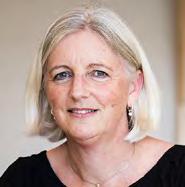
> BY ANDREA SCATCHARD
Andrea Scatchard is a Tax Partner at Deloitte, based in the Bay of Plenty. She can be reached on ascatchard@deloitte.co.nz
to income tax or GST/VAT in that country?
The answers to these questions will vary from country to country and often the amount of time the employee wants to work in a country may dictate whether or not you (or the employee) will have tax obligations there.
The key message is – be prepared. Do some homework and seek advice if you need to. The last thing you want is for you or your staff to run into trouble with the local immigration or tax authorities.
Overseas business travel
If you or your staff are embarking on offshore business travel, the same issues as above are relevant, but you may be visiting many locations which increases the homework you need to do.
On the flip side, if you are only in a country for a short time this should reduce the possibility of tax issues arising, but you will still need to think about whether you need a visa to conduct business there.
When you or your employees travel for work, you will incur a range of costs including airfares, taxis and rental cars, hotels, meals, and incidental expenses. You might also decide to add on a holiday during a work trip or take your partner or family along for the ride.
When it comes to working out which costs are deductible to the business, and which are not, you’ll need to be clear about what the costs relate to and check that you’re treating them correctly.
The rule of thumb is that if there is no private element to the travel, or it is only incidental, then the costs should be deductible and there should be no PAYE or FBT in relation to employee travel.
However, if the costs relate to both a business and a private expense (for example an employee adds a holiday to the business trip, or you take you partner or family with you) you will get a different outcome.
If the costs relate to your staff then you will likely have a PAYE or FBT liability for the private component of the costs.
Inland Revenue has had a real focus on what it considers “private” expenses in recent times, and in line with this has recently released a draft Questions We’ve Been Asked, Deductibility of overseas expenses, which sets out some guidelines on what is deductible and what isn’t.
Not always better the devil you know
Better the devil you know is a common saying but in business the devil you know could be doing you serious damage.

There have been a few incidents I am aware of where people have been working within a business while also working for the business’ competitors.
We have seen cases of builders working in a company and sending plans and pricing information for future projects to a competitor in exchange for a future, more well-paid position or other more immediately realised rewards. The other builder then contacts the client and quotes a lower price, often then getting the work.
In another case an employee of a motor vehicle dealer that bought a lot of used cars from the public was offering the sellers insultingly low prices for their vehicles on behalf of his employer.

CREDIT CONTROL
> BY NICK KERR
Nick Kerr is regional manager for DebtFree NZ Ltd and director of International Private Investigations Ltd. He can be reached on 021 876 527 and Nick@debtfreenz.com
He would then explain to the often-angry sellers that his company didn’t pay very much for cars, but he had heard there was a place across town that paid “far too much” for cars and he would then give the seller the details.
The seller would, more often than not, turn up at the car dealer across town who would already know the price offered and would offer them a price still significantly less than its wholesale market value but by comparison to the last offer, a vast improvement,
even when the first employees commission was deducted.
There are some ways to limit the occurrence of damages due to leaked information:
• Have key employees disclose their connection to, and affiliations with, key competitors.
• Have strict data protection clauses in employment agreements as well as a non-acceptance of non-declared gratuities clause.
• Do not allow personal email accounts to be

accessed from company devices as these could make it difficult to track the diversion of company data. Have individual logins for CRM and business data systems so you can identify the parties who have accessed information correlated to a data breach.
• Limit access to pricing, future work and business critical data to those who absolutely need to access it. People can’t share information that they don’t know. Just a thought.
Resigned to working… for now
You may know that the opportunity this column provides me to crystal ball gaze is perhaps my greatest little indulgence, and I do my best to keep it to once a year. However, a year is a long time in the current ever-changing world, so I can’t help but want to go back to one of the predictions I made earlier this year and see how it is playing out – the great resignation.
During the first lock-down I commented that many people, having spent months working from home, would not want to return to the restrictions and prescriptions of “working for the man”.
At the time I was quietly assured we were about to see a seismic shift of how people wanted to work and that this would flow onto growth of franchisee entrepreneurship.
The premise was that people were going to leave their jobs in droves, and some of these would seek a franchised business.
At the start of 2022 I revised my view, suggesting that we were yet to really see that in New Zealand the initial wave, which was just a hint at the start of the very first lockdown, had all but ebbed.
In the US the recent experience is that the great resignation has added fuel to franchise growth. 2021 saw an estimated growth in franchise business units of 3% – which is not a small number when considering a base of around 750,000 units.
However, US growth has not been consistent across
sectors, with some categories experiencing expediential growth, some doubling or tripling their size, while others have contracted. This indicates to me that perhaps the primary driver was not the great resignation but other economic or market changes presenting opportunities for growth.
Increasingly, I don’t think the great resignation is happening in New Zealand, and I am firmly of the view that it certainly is not filling the pool of potential franchisee entrepreneurs – a view shared by Simon Lord of Franchise New Zealand Media (www.franchise.co.nz).
The veteran commentator shared some insights from their digital and print presence and suggested that while last year had been a bumper year for interest – fueled by lockdowns – ongoing uncertainty meant that actual enquiries were very industry dependent.
While interest is still high, that trend is continuing. So why are we not seeing the great resignation, and its perceived flow-on to franchisee entrepreneurship?
Changes in employment and the balance of power
In my mind perhaps the greatest single contributor to the great resignation, and apparent pain point, the “turning up to work” component, has been addressed.
New Zealand work culture has dramatically changed post-Covid. There is barely an industry that has not been forced to respond to flexible work arrangements.
Increasingly, people can work where and, in many cases, when they want, providing them the golden double of work life balance with the security of employment.
Funding is a challenge
Simon revealed that enquiry in the lower investment levels – sub $200,000 – is strongly up but, above that level, at best flat or down, especially in hospitality.
Our experience is similar, but critical to note, the higher investment level enquiry is coming from potential franchisee entrepreneurs that have liquid capital at their disposal
New Zealand work culture has dramatically changed post-Covid. There is barely an industry that has not been forced to respond to flexible work arrangements .”


FRANCHISING
> BY NATHAN BONNEY
Nathan Bonney is a director of Iridium Partners. He can be reached at nathan@iridium.net.nz or 0275-393-022
and are not reliant on funding. Whether actual or perceived, we’re hearing the message: it is very difficult to borrow or fund a business purchase.
Low levels of unemployment and wage growth
Historic low levels of unemployment and an unsurprising
recent report of wage growth of 8% mean people are remaining in their current roles or moving for more pay. They do not however appear to be leaving the job market to start a franchised business, for now at least.
The future remains bright
My last point for now is an
important one: While we are not seeing the great resignation at the moment, current economic and social environments have created time and opportunity for people to research and evaluate their options, including becoming a franchisee entrepreneur. I think we may be returning to review this in the future.
Sign up now to pay your regional council rates by direct debit!
The 2022 – 2023 Bay of Plenty Regional Council annual rates invoices have started being sent out to ratepayers across the region.
We want to be more transparent and accountable for the work we do for you, so for the first time since the Regional Council was formed in 1989, we are collecting our own rates. Until now, we’ve contracted this out to the region’s city and district councils to do this on our behalf.
There are plenty of ways to pay your rates invoice, including by direct debit, in person at one of our offices, at your local NZ Post Office shop or online.
Direct debit means you can pay your rates invoice in regular instalments (weekly, fortnightly, monthly, or annually), which is handy for budgeting and means you don’t have to worry about remembering to make a payment.
It also means that you won’t get charged a penalty on any amount that is still owing after the due date of 20 October for the current rates year.
For any changes to the payment amount, we’ll always let you know before taking the funds from your account and you can cancel the direct debit at any time by contacting us.
For more information about the changes and how to pay your rates go to boprc.govt.nz/rates or call our rates team on 0800 BOP RATES (0800 267 728)
Find out the cost of your 2022-2023 regional council rates on our website or at one of our offices using the Rating Information database (RID).

Note: ratepayers will continue to receive rates invoices from their city or district council for the services they provide, which will need to be paid to them.
Warning: The biggest business mistake you’ll ever make
Kiwi companies are sleepwalking into a trap, and they don’t even realise it. Only the smartest business owners will be able to avoid disaster…and it will mean doing the exact opposite to everyone else.
Marketing is like sex. Everyone thinks about it. Most of us would like to be doing more of it. Very few people are doing it properly. And if you need to pay for it…you’re a bit of a loser.
Personally, I spent many years doing it badly. Then I found someone with more experience who showed me how to get really good at it. Before long, punters were offering me money to do all kinds of crazy things, and I gladly accepted.
Perhaps that makes me the biggest loser of them all.
But the fact I’ve spent years learning the dark arts of my craft does put me in a slightly awkward position for what I’m about to tell you … As a marketer who has advised the likes of Coca-Cola, Heineken, Virgin Atlantic, Microsoft, Vodafone and many more, I can say with some authority: Investing in more marketing for your business could be the biggest mistake you’ll ever make.
Getting Naked
Yes, I know, spouting such blasphemy will probably get the marketing gurus spluttering their flat whites all over their beards and checked shirts.
One of these days you’ll walk up the Mount and find me at the top, naked and hog-tied, as a warning to other souls who dare criticise the cult of S&M (Sales & Marketing – get your mind out of the gutter).
So please allow me to reveal a little more about why
I – as a marketer– am warning you against marketing.
On the surface, it all seems so innocent: Marketing brings customers. Customers bring sales. Sales bring money.
But what if you looked at things a different way?
Maybe it’s because I’m British, but I tend to see things upside-down.
Here’s my perspective: Businesses must only focus on selling because they failed at marketing. They only did marketing because they failed at their product. They failed at their product because they failed to understand their customer.
Then, when they get themselves in a pickle, they crack the whip on the sales team, shovel some more coal into the marketing furnace and hope for the best.
It’s like the designers of the Titanic throwing a few more trumpeters into the band and adding some more deckchairs … while totally ignoring the fact that their product might not be serving the needs of their customers.
But here’s where we get really controversial; Because I believe that to thrive in 2022, businesses need to change course: Focus LESS on the shiny creature comforts of marketing, and MORE on understanding their customer.
When you understand your customer better, you can create products and offers they love.
If they love the product and the offer, then you don’t need to worry

MINING BUSINESS WEALTH
> BY FREDDIE BENNETT
Guinness World Record Holder, podcast host and bestselling author, Freddie is known as ‘The Profit Hunter’. He helps business owners enjoy more time, money and freedom by discovering and extracting hidden profits in their companies. Freddie@conqueryourmedia.com
pany that perfectly understood your situation and was able to solve your problem in the most effective way.
So, if you want to spend less time, money and effort making messy S&M mistakes (Sales &

Sink or Swim
I have a phrase that’s as old as the Titanic, but in the modern era of jazzy influencer marketing and shiny social media ads, it’s quietly gone out of fashion. So it’s time for a revival: ‘A good product sells itself.’
about ‘marketing’ or ‘selling’ it.
Do you need a ‘unique marketing hook’ when you spend thousands of dollars on braces for your kid’s teeth, or an engagement ring, or new boat engine, or a new garage door because your son wanted to test out his go-kart ram raiding skills?
No. You needed a com-
Marketing, remember) ... how do you give your customer the product they truly want?
Do you get me?
Yes of course YOU know your customer, don’t you? You’re the one person who really ‘gets it’.
Except you’re not.
Business owners kid themselves that they know
their customers. Usually, it’s because they’ve been in industry for decades, or they’ve had the same customers for years.
Occasionally, a real crazy maverick even takes the time to ask a customer what matters to them. Madness.
But when it comes to designing products, offers and services that sell themselves, we have to go a little deeper into how our customers behave and think.
For example, men and women buy differently. Men seek status, women seek security. Men like logical sales processes, women are more drawn towards insightful, creative stories. Women see more vivid colours than men. Men are 20 times more likely to be colour-blind than women.
Before you send a hateful protest down to the Bay of Plenty Business News offices, let me say that these are merely scientifically-proven generalisations, and there will always be exceptions to the rule.
But too many companies are burning precious marketing dollars selling products to their audience in the wrong way.
To give you another exam-
ple that’s less likely to get me cancelled by the ‘highly-offended’ brigade: If your customer is more of a process-driven type (engineers, technicians, IT, building and construction, etc) they are going to be asking lots of questions about ‘HOW’ your product and services work.
But if your customer is more of a creative type (retail, recruitment, consumer goods, media, art, etc), they will want to know ‘WHY’ your offering does what it does, and the story that led to its creation.
If you take the time and care to get to know the demographics and psychographics of your buyers, and tailor your messages and products accordingly, then you won’t have to make the biggest business mistake…
…which is resorting to using sales and marketing as a battering ram to crush your prospect’s spirit and wear them down until they begrudgingly hand over their credit card. My approach is slightly longer, but by golly, your customers will love you for it. And you’ll like the person you see in the mirror as well.
That’s why I’m an ‘ANTI’-Marketer…and I’m proud of it.
So if you spot me looking a little tied-up at the top of the Mount this weekend, please come and say hello.
GST – Goods and Services Tax
Goods and Services Tax (GST) is a form of value added tax introduced in New Zealand on 1 October 1986. The current GST rate in New Zealand is 15%. Taxpayers who are registered for GST have an obligation to file regular GST returns and pay GST to the IRD by certain dates.
Currently, if your turnover is expected to be more than $60,000 in the next 12 months you should register your business for GST. It does not matter what business structure you are using – a Sole trader, a Company or a Partnership – all fall into the same regime of compulsory GST registration. The registration process is pretty straight forward, and this can be done online, or by your accountant.
Here is an example of how this value added tax works: If you purchased a product and paid $115 for it, there is a GST credit in this amount of $15. As part of your business activities, you will be adding value to the product and later selling it to your customer for, say, $184, which will include the GST component of $24.


BUSINESS ACCOUNTING
> BY VALERIE ROWE-MITCHELL
Accounting and other money matters with Valerie Rowe-Mitchell, owner of Emerald Business Advisers. Valerie can be reached on 07 579 5777 or valerie@emeraldbusiness.co.nz
The GST to pay will be only on the added value and will be calculated as $24 (GST collected via sale) less $15 (GST paid to the supplier), $9 is the GST to pay to the IRD on the added value.
GST: impact on cash flow
Your cashflow may be negatively impacted if you are required to be registered for the GST, but unable to increase your prices by 15%. We see this happening with service providers, who struggle to increase the prices due to competition, or customers’ resistance to an increase. However, if you are registered and have been operating your business for a while, you know that there is positive
impact on the cashflow as the GST payment is due to the IRD once every two months (the most common set up) and the business holds the collected cash and is able to pay other bills meanwhile.
Zero Rated for GST
Some GST transactions are zero rated. Generally speaking, these are exported goods and services, an example being when a person works remotely for an overseas customer. Also, real estate transactions between two GST-registered entities are zero rated. The most common transaction will be the sale of a real estate, where both the vendor and the buyer, are GST registered and the purchase comprises land.
Exempt from the GST
Certain transactions are completely exempt from GST. For example, financial services such as the bank fees, residential accommodation (rents), supplies by non-profit bodies, and the supply of fine metals (gold, silver) – all of which are GST exempt. Some transactions are outside the scope of GST altogether such as gifts, or they may be made by entities that are not registered (and are not required to be registered).
The best practice is, if you are in doubt about GST, get in touch with your accountant. Tax laws are complex and a quick phone call today, can eliminate a costly problem tomorrow. Talk soon!

The Prince’s NewToy,2000 x 1700mm, acrylic on canvas,2022.
History meets art in Tauranga
Tauranga Art Gallery Toi Tauranga in partnership with Seeds Trust is delighted to announce the opening of Folk Nationalism, an exhibition of new paintings by Tāmaki Makaurau-based artist Ayesha Green (Ngāti Kahungunu, Kai Tahu).
Folk Nationalism will be presented across Tauranga Art Gallery’s ground level galleries and features a substantial new body of paintings developed by Green over the past year. Her large scale canvases and works on paper interrogate histories of Māori and Pākehā representation and the role that images and language play in perpetuating systems of power.
While Green’s paintings are often characterised by her simple rendition of figures and forms, they represent a bold approach to issues concerning her Māori whakapapa – passed down through women over four generations. Green’s work has been profiled in important exhibitions, including a solo presentation at Dunedin Art Gallery and participation in the major 2020 survey of contemporary Māori art, Toi Tū Toi Ora. Green is the second recipient of the prestigious bi-annual Rydal Art Prize, for which she received $25,000 and the opportunity to develop this exhibition for Tauranga Art Gallery’s 2022 programme. Established in 2019 to acknowledge an artist who has made a substantial contribution to contemporary painting, the non-acquisitive award celebrates the vitality that painting continues to have within the diverse contemporary art field

in Aotearoa New Zealand.
Tauranga Art Gallery Director Stephen Cleland says: “We’re thrilled that the Prize has enabled Ayesha to develop this ambitious body of work that traverses reclaimed and re-presented moments and movements in Aotearoa’s history.
“As the inaugural venue to present this entirely new body of paintings by Green, it’s exciting to see unveil new developments in her practice and see a focused and concentrated dialogue with a longer history of painting in Aotearoa emerge, from Marcus King’s 1938 history painting depicting the signing of the treaty to several pioneers of contemporary painting across the 20th Century. In each Green teases out conflicting histories and how they continue to form our national identity.”
“It’s made in New Zealand”… but is it?
Regular readers of this column may recall that in March this year I wrote an article entitled, “It’s coming home … the return of NZ’s IP”.1 The article was about how, due to issues of control, speed and cost, New Zealand businesses appear to be moving production of their goods back to New Zealand or just making their products here in the first place.
If you’re one of those businesses, you might want to consider using the label ‘Made in New Zealand’2 in connection with your products.
If you do, then be careful how you proceed because while using ‘Made in New Zealand’ in relation to finished products which have been 100% grown/extracted/ produced in New Zealand is straightforward, using the label in relation to finished products ‘made’ from a mix of imported and locally produced materials or components is more complicated.
To determine if the ‘Made in New Zealand’ label is appropriate for a product ‘made’ from a mix of imported and locally produced materials, the New Zealand courts will examine whether on their way to becoming part of a finished product, the basic ingredients of that product have gone through a ‘substantial transformation’ in New Zea land, or whether a key step in producing a final product has been undertaken in New Zealand.
The Buy New Zealand Made Campaign, which licenses use of a ‘New Zea land Made’ logo, interprets ‘substantial transformation’ and ‘key step’ as ‘a signifi cant manufacturing process’.
More fully, its ‘Manu facturing Eligibility Guide’ asks the question, “Have the imported key mate rials/components been through a significant manufacturing process in another country and [do they] form the essential char acter of your fin ished product?”
If the answer to that question is

INTELLECTUAL PROPERTY ISSUES
> BY BEN CAIN
Ben Cain is a Senior Associate at James & Wells. He can be contacted at 07 928 4470 (Tauranga), 07 957 5660 (Hamilton), and ben.cain@jamesandwells.com
‘yes’, then it is unlikely that the product will qualify as ‘New Zealand Made’.
If the answer to that question is ‘no’, however, the Guide goes on to ask, “Do the imported materials/components go through [such] a significant manufacturing process in New Zealand that the form in which [they] are incorporated into the finished product is distinctly different from the original imported form?”
If the answer is ‘yes’, then the Guide advises that the product may be eligible to use the logo but there remains
sequently, appropriate legal advice should be sought.
As I noted earlier, the ability to use ‘Made in New Zealand’ in connection with products ‘made’ from a mixture of imported and locally produced ingredients is complicated.
Using the ‘Made in New Zealand’ label2 can be a significant source of competitive advantage and beneficially contribute to a business’s reputation. As His Honour Judge DJ Sharp, in a 2019 District Court judgment3 concerning the misleading application of ‘New Zealand Made’ to

[34] [‘New Zealand Made’] representations are representations that may provide a sense of affinity to consumers. Consumers may see products as desirable as a result of being made in New Zealand. Consumers may also see beneficial aspects that they can attribute to the products such as products being provided from an environment in which there are standards and in which environmental concerns might be better met than some elsewhere. In closing, if you’re a business considering using ‘Made in New Zealand’ or ‘New Zealand Made’, don’t be put off from doing so just because the answer as to whether you can or can’t is not straightforward. Seek appropriate legal advice, as recommended by the Buy New Zealand It may well be that your products can be labelled ‘Made in New Zealand’; but if they can’t, you might still be able to use another classification like ‘Built in New Zealand’ or ‘Assembled in New Zealand’ which at least identify New Zealand as the country in which the final finished product was produced.
1. If you haven’t read it, fear not, you still can here: https://bopbusinessnews.co.nz/intellectual-property-issues/its-coming-home-the-return-of-nzs-ip/. 2. Or the associate labels ‘New Zealand Made’ and ‘NZ Made’
3. Refer: Commerce Commisson v Go Healthy New Zealand Limited [2019] NZDC 25295.

“From the Dale Carnegie programme I have learned many valuable skills and will continue to utilise the “golden rules” on a daily basis in my life. In particular I think that the principle of learning to disagree agreeably will be invaluable for me as this is an area that I have always struggled with. Thank you for facilitating such a great learning experience!”
– Kristin Bridges,
Insurance
Take Command
Developing leadership skills is an extremely fulfilling journey that takes time and the right guidance. For over 100 years Dale Carnegie has specialised in helping people take command of their work and future, whatever the stage of their journey.
Leadership Development Framework
• Step Up to Leadership
• The Dale Carnegie Course: Skills for Success
• Develop Your Leadership: Stop Doing Start Leading
• Leadership Training for Results: Unleash Talent in Others
• High Impact Presentations
Dale Carnegie BOP Waikato 07 579 0484
www.bop-waikato.dalecarnegie.com
Senior Broker, Bridges
Ayesha Green Photo/Jameela George
NZ Festival of Squash is coming to Tauranga
The largest squash festival in the nation’s history will be held later this year with the two tournaments running back-to-back on a purpose-built glass court at the Trustpower Arena in Tauranga.

3-6 NOVEMBER – NATIONS CUP | 8-13 NOVEMBER
– NZ SQUASH OPEN
From November 3rd – 6th, New Zealand will be the first country in the world to host the Nations Cup which comprises eight teams of two players – one male and one female – from 12 countries.
The New Zealand Open men’s and women’s PSA World Tour Silver event will follow from the 8th-13th November and boasts a US$150,000 prize pool. The festival also includes some exciting local tournaments with opportunities for all grades to compete. Come and watch some of the best squash players in the world.
Nations Cup
New Zealand will be the testing ground for a major initiative for squash with the launch of the Squash FORWARD Series, a sequence of new squash events intended to trial innovative changes to the way the sport is delivered.
The Nations Cup will comprise eight teams of two players – one male and one female – from the same country to add a new dimension to the typical competition structure in squash. It will also include an alternative scoring format.
New Zealand Squash Open
The biggest squash tournament on the NZ squash calendar is back!
The Robertson Lodges New Zealand Men’s Open and the Barfoot & Thompson NZ Women’s Open will be PSA World Tour events with NZ’s own Paul Coll and Joelle King set to be the star attractions amongst a top-class field that will line up at the Trustpower Arena in Tauranga on all glass court. Players will battle for the lion’s share of a US$150,000 prize fund.
Tickets are selling fast and available at NZ Festival of Squash (iticket. co.nz) – more information at www. festivalofsquash.co.nz
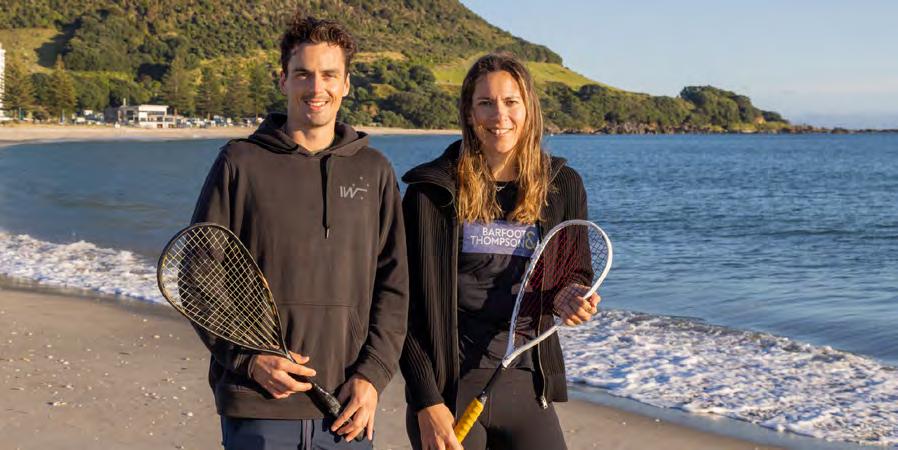
The Women’s Lifestyle Expo –17 & 18 September 2022
The Tauranga Women’s Lifestyle Expo is bringing 140 of the best lifestyle companies together, showcasing all the fashion, beauty, health, fitness, gourmet food & beverages and much more. The expo will have something for everyone. It’s the perfect opportunity for a girls’ day out, or to treat yourself to a day leisurely wandering between exhibitors.
Bay of Plenty Baby Expo –24 & 25 September 2022
An expo not to be missed if you have little ones. A weekend of expert, up-to-date advice, seminars, and workshops. A complimentary Creche, Parents Room and Mothers Room are provided onsite to ensure you have everything you need to visit in comfort. Free entry.
NZ Bridge Congress 2022 –1-8 October 2022
The New Zealand Bridge Congress will be hosted at Trustpower Arena.
This highly anticipated event attracts the best Bridge players from across the country to compete and celebrate the card game they love. Top international level players mix and meet less experienced players and vice versa – it is a rich exchange and a highly exciting environment.
This event includes national events for all categories of competitive bridge players: Open, Intermediate and Junior. Players are required to register to participate. Spectators and supporters are welcome to attend free of charge.
Demi Lee Moore New Zealand Tour – 7 October 2022
International star Demi Lee Moore is coming to the Trustpower Baypark Stadium Lounge with her latest album Jy Ken My Naam, which has reached Golden status across South Africa. Demi Lee was first introduced to the South African audience in 2014 when she reached the top seven on Season 10 of Idols.
She went on to be the first winner of the television show Die Kontrak. This paved the way for her success in
See NZ’s Commonwealth gold medal winning squash players Paul Coll and Joelle King in action at Baypark Arena.
the music industry. Her latest album Jy Ken My Naam, was released in late 2020. www.eventfinda.co.nz/2022/ demi-lee-moore-tour/mt-maunganui
Silver Ferns v Australian Diamonds – 16 October 2022
The Silver Ferns will defend their Constellation Cup title when they meet the Diamonds in four Tests, played as part of the Cadbury Netball Series. The rivalry resumes on this side of the Tasman at Spark Arena in Auckland on 12 October and Trustpower Arena Tauranga on 16 October.
The Silver Ferns then head off on their first trip to Australia since late 2019, with matches on Wednesday 19 October and Sunday 23 October. Trustpower Baypark is delighted to be selected for one of the two tests to be played in NZ – guaranteed to be a sold-out event.
HoopNation “The Classic” –21-24 October 2022
The electrifying atmosphere of The Classic is unparalleled in the sport events marketplace and has quickly
become the ‘must-attend’ event on the basketball tournament calendar. The fusion of music, the vibe and energy of athletes, and the detail of venue presentation make HoopNation branded events world class.
Speedway – Bay Summer Starter – 22 October 2022
Join us for the Bay Summer Starter 2022/23 Season Opener! This promises to be a huge night of Speedway racing action just in time for the warm weather of Summer. Tickets will be available at the gate and via the Speedway website from mid-September. Check out our family Zone with displays, merchandise and other exciting new stuff this season presented by Mediaworks. Gates open 5pm and racing starts from 6pm.
The Tauranga Home Show –28-30 October 2022
Draw inspiration for your home from 300+ exhibitors bringing you everything you need to build your dream in the Bay of Plenty at Tauranga’s largest home and lifestyle event. Jo Seagar will be demonstrating live at 11.30am and 2.30pm each day with her natural wit and charm, showing you recipes from her latest cookbook Better Than A Bought One. Jo is famous for her catchphrases: ‘easy peasy’ and ‘maximum effect for minimum effort’ – don’t miss this chance to see her live at the Tauranga Home Show.
Tauranga’s Premier Venue
Trustpower Baypark is Tauranga’s premier venue for conferences, meetings, entertainment, and exhibitions. Offering a complete package in one convenient location, featuring state of the art meeting rooms, in-house catering, audio visual services, marketing/ promotional services.
SCION SAYS BIENVENUE
AND NAU MAI HAERE MAI TO NEW GENERAL MANAGER
Scion welcomed Henri Baillères as its new general manager of Forests to Timber Products in August.
Dr Henri Baillères has deep research and industry experience in forestry and wood product innovation. Most recently, he was product development manager at Hyne Timber in Australia, an industry leader in the manufacture, optimisation and application of cross laminated timber (CLT) and Glulam products. Before that, he led the Forest Products Innovation Team of the Queensland Department of Agriculture and Fisheries. Baillères has also worked on forestry and wood product projects in several countries in Asia, the Pacific, and Africa.
Scion chief executive Dr Julian Elder says he is really pleased that Baillères is joining the team.
“He’s well known to us having visited Scion a number of times, and his international industry leadership in advanced timber engineering will further strengthen our world-leading forest to timber products impact area.”
Baillères says it is an honour and a privilege to join the Scion team, which enjoys a strong international reputation and leadership position in many areas of research with a wide range of high-level work.
“Scion’s ambitious strategy for New Zealand will be transformational and pave the way for the development of a thriving new bioeconomy.
“I am ready to embrace my new position with enthusiasm and passion, where I expect to add value through my technical and scientific expertise, my understanding of the forest-wood value chain and my enjoyment of multidisciplinary teamwork.”
Baillères was born in Toulouse, the European capital of the aeronautics and space industry. His scientific career began with CIRAD (French Agricultural Research Centre for International Development) studying the structural properties of wood from hybrid eucalyptus plantations in the Republic of the Congo. His research spans the broad spectrum of the forest-based sector, reflecting his technical skills, engineering background and research experience in wood science and technology. He has published widely in forest and wood science and engineering.
His qualifications are a PhD (Wood Science from the University of Bordeaux), a MSc in Wood Science (Paris-Saclay University) and a Master of Engineering in Wood Industry and Technology (University of Lorraine, France). He is a Fellow of the International Academy of Wood Science (IAWS).
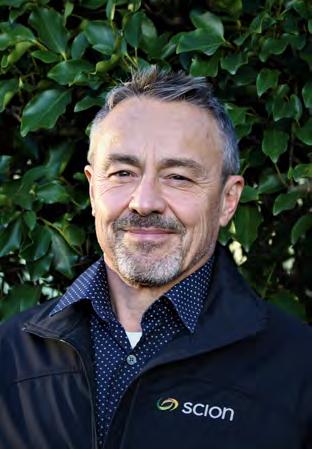
What’s the key to improving SME productivity?

Kiwis have a competitive spirit, putting us in good stead when it comes to things like sports achievement internationally.
So why aren’t we as competitive when it comes to being the most productive country?
Xero worked with the New Zealand Institute of Economic Research to understand where Kiwis ranked in the OECD when it comes to productivity versus amount of time worked.
Unfortunately, the results weren’t as glowing as our Commonwealth Games medal tally.
Every day, New Zealanders are working more than their international counterparts – and have less to show for it. In fact, Aotearoa’s labour productivity is below the OECD average and is operating at less than half of
WORKPLACE WELLBEING
> BY BRIDGET SNELLING
Bridget Snelling, Xero New Zealand Country Manager.
the most productive nation, Ireland.
To match the Irish and their hourly productivity output, Kiwis would need to work 55 more hours every week – or an additional 10ish hours a day – something physically impossible to do. Even for us to compete with our geographical neighbour Australia, we’d have to be working for an extra two-and-a-half hours a day.
Overall, Kiwis would need to work 20 percent more to reach the average OECD GDP output, which would mean working an extra day on top of a regular 40 hour week – and this is just to reach the average productivity mark.
For business owners, the equivalent would be hiring one more employee for every five current employ-
ees. This is a near impossible challenge at the moment, considering the tight labour market.
The answer isn’t working harder, but working smarter. This is where technology becomes crucial to helping streamline small business productivity.
For local Bay of Plenty small business owners grappling with where to start, there’s something I like to say: You don’t need to change everything at once.
Identifying the tasks you and your staff are spending too much time on is the first step, figuring out what the pain points are in your business, and looking at the technology options available to help. For example, are you spending too much time on invoicing and chasing outstanding payments?
We know this is a chal-
lenge for a lot of Kiwi small business owners at the moment. This delay in payments has an impact on their bottom line and can be extremely stressful to boot.
Anything we can do to make payments more efficient is really beneficial. And there’s a solution on the horizon for all Kiwi businesses to consider.
E-invoicing will automate the sending, receiving and payment of B2B invoices. While the platform is yet to launch in Aotearoa, small businesses can register interest for when it launches by heading to the Government’s e-invoicing website.
In fact, the New Zealand
Government estimates e-invoicing could save our economy $4.4billion over the next 10 years by improving cash flow and reducing the amount of administrative time.
However, this is just one example. Stocktaking, employee rostering, supply ordering, e-commerce opportunities – the world is your oyster once you start digging into technology solutions.
Ultimately, productivity gains are an accumulation of several small changes to how you and your team do business. It’s a gradual process, and all you need to do is take the first step.
Phishing attacks becoming more sophisticated
Analysts from Zscaler’s cybersecurity research team have discovered a new large-scale phishing campaign targeting Microsoft email users. Corporate users, specifically end users in Enterprise environments who use Microsoft email services, are the campaign’s primary target audience.
Attackers use Adversary-in-the-Middle (AiTM) techniques to circumvent multi-factor authentication (MFA) safeguards. In early July, Microsoft disclosed information about a similar attack. Microsoft described an attack that targeted over 10,000 organisations and bypassed MFA protections using AiTM techniques.
According to the Microsoft Report: “A large-scale phishing campaign used [AiTM] phishing sites to steal passwords, hijack a user’s sign-in session, and bypass authentication even when [MFA] was enabled. The attackers then used the stolen credentials and session cookies to gain access to the mailboxes of the affected users and launch subsequent BEC campaigns against other targets.”
Zscaler describes the new attack as “highly sophisticated”, saying, “It makes use of an [AiTM] attack technique capable of circumventing multi-factor authentication [as well as] multiple evasion techniques used in various stages of the attack designed to cir-
cumvent conventional email security and network security solutions.”
The malicious campaign is primarily targeting businesses in the United States, the United Kingdom, New Zealand and Australia. FinTech, lending, finance, insurance, accounting, energy, and federal credit unions are the primary industries.
The attack begins with phishing emails sent to Microsoft email addresses. Everything hinges on how users react to these phishing emails. Malicious emails, as well as HTML attachments containing the link, may contain a direct link to a phishing domain. In any case, the user must activate the link for the infection chain to begin.
Similarly, to the earlier phishing campaign described by Microsoft, phishing emails in the uncovered campaign entice users with a variety of topics. One email stated that an invoice needed to be reviewed, while another stated that a new document needed to be viewed online.
The campaign employs

several redirection techniques. For example, in the campaign, it “rapidly created new code pages, pasted into them a redirect code with the latest phishing site’s URL, and proceeded to email the link to the hosted redirect code to victims en masse.”
The phishing sites used fingerprinting techniques to determine whether a page visitor was a targeted victim of the campaign or not. According to Zscaler, this is done to make access to phishing sites more difficult for security researchers. To connect the user’s device to the target service, AiTM phishing attacks use proxy servers. They manipulate and regulate data flow. Finally, it is grabbing
TECH TALK
> BY MARIETTE TOLMAY
Mariette Tolmay is the marketing lead at Stratus Blue. She can be contacted at mariette@stratusblue.co.nz.
session cookies generated during the process to allow access to the email service without having to sign in again or using MFA to complete the sign-in process.
Phishing campaigns are becoming more sophisticated, but they all share one feature: they all require user interaction. The vast majority of users are unable to analyse emails in order to determine whether they are from a legitimate sender.
While Microsoft 365 Defender can detect these sophisticated phishing techniques, an organisation can add another layer of security to its website by combining multifactor authentication with custom conditional access policies that look for identity markers such as IP
location, device status, and group membership. It is also recommended that additional security solutions for AiTM attacks be included. “Invest in advanced anti-phishing solutions that monitor and scan incoming emails and visited Web sites,” according to the report. “Businesses, for example, can use web browsers that detect and block malicious websites, such as those used in this phishing campaign.” Finally, educating end users on how to detect these phishing attempts will aid in lowering their success rate. “Watch for suspicious sign-in attempts (for example, location, ISP, user agent, or use of anonymizer services),” Microsoft advised.
Henri Baillère
WINE ATHLETES PREPARE TO DRINK FOR TAURANGA!
Comedy Cellar, New Zealand’s largest amateur (team) wine tasting event and a huge night of laughs, learning and entertainment, is back in town on Saturday, December 3rd at the spectacular venue, the Classic Flyers Aviation Museum, Mt Maunganui.
Comedy Cellar is a blend of two of life’s great joys, wine and comedy and is a fun and entertaining night and a great end of year team builder.
There is, however, a serious catch on the night as wine athletes from around Tauranga assemble their teams for the chance to not only become Tauranga Comedy Cellar Champions (aka the best wine drinkers in town) but provincial wine drinking representatives and possible national wine drinking champions!
Comedy Cellar allows local teams (tables of 8 to 12 persons) to ‘drink and compete’ against other local teams (typically made up of colleagues, clients, and friends) with scores given for correct
answers on wines served to the table.
Only one answer per table (team) may be submitted to the judge, so teams must first debate and agree on the correct answer to submit.
Four wines are served over the evening, and up to eight questions are asked about each wine. Some scores may not be revealed until the final round making for a tense run to the finish line!
After a local Tauranga champion is found, crowned and presented with the appropriate silverware, all scores are then averaged and compared to other regions around New Zealand via the leader boards on the Comedy Cellar website (updated after every event).
So as Comedy Cellar moves
around the country, we get to find out who the nation’s best wine drinkers in New Zealand are (let’s go Tauranga)!
Michele A’Court and Bob Campbell will be co-hosting this year’s Comedy Cellar.
Comedy Cellar is co-hosted by New Zealand’s foremost wine expert and guru, Bob Campbell (the Cellar) and top entertainer Michele A’Court (the Comedy).
The organisers stress this is an entirely amateur event, and anyone with a formal wine qualification is actually banned! Alongside the competition wines, a full bar service is also available, and the evening is catered.
Full details are available from the Comedy Cellar website: www.comedycellar.co.nz

NZ’S LARGEST AMATEUR (TEAM) WINE TASTING COMPETITION AND A HUGE NIGHT OF LAUGHS, LEARNING AND ENTERTAINMENT!
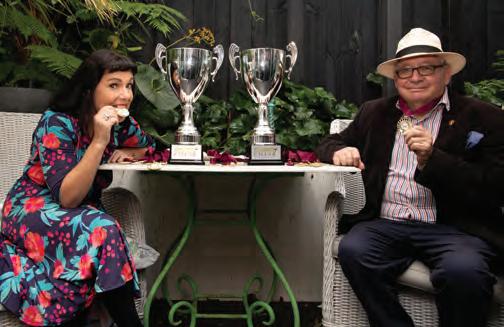

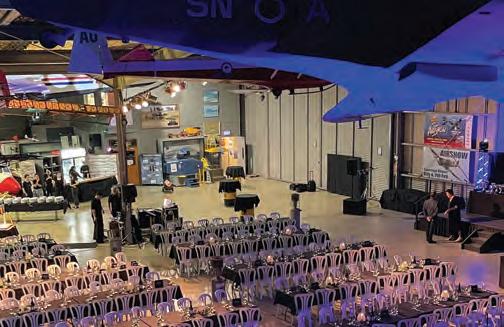
Life in the fast lane

Industrial leasing markets across the country are incredibly tight and tenants need to move quickly to secure space.
New Zealand’s industrial leasing sector is being squeezed from all angles with unprecedented demand for space, historically low vacancy rates, shortage of new stock, and pandemic-related business fundamentals all contributing to significant pressure points.
Space is at a premium with businesses right across the industrial spectrum actively looking for premises and competing for the limited opportunities that become available.
In Auckland and Wellington, leasing often occurs prior to the property becoming physically vacant and this highlights the benefits of actively engaging with Bayleys’ leasing team to get the jump on opportunities.
“Our teams across the country have ears to the ground, working closely with landlords and keeping abreast of development pipelines,” says Scott Campbell, Bayleys’ National Director of Industrial.
“Businesses that are looking to scale up, downsize, change location or upgrade in terms of quality are approaching us directly in the hope of finding premises that will enable them to streamline and optimise their operations.”
“Locally in Tauranga we are seeing strong demand from industrial tenants who are looking to grow or establishing additional hubs in the region with a strong desire to be located near the Port of Tauranga and key arte-
rial routes,” says Bayleys Commercial Tauranga Sales Manager Mark Walton.
“Vacancies for industrial buildings in Tauranga are at record lows with sub-1% vacancy and vacant industrial land in the area particularly scarce, so we are unlikely to see much additional supply come to market in the Western Bay of Plenty until the new Rangiuru Business Park comes on stream.
“For any tenants that have requirements over the next few years we do recommend planning early and working with your Commercial Agent to review your requirements and consider options,” Walton advises.
There are multiple factors contributing to the industrial market’s momentum. Demand for warehousing driven by growth in ecommerce is the main one, while the step change from “just-in-time” to “just-in-case” logistics strategies behind the need to hold greater levels of inventory is driving requirements for properties with scale.
Campbell says in Auckland, where vacancy rates are at all-time low averaging 1.6-percent across precincts, the situation is becoming acute.
“It’s so dire, that there are emerging examples of landlords running rental tenders rather than traditional negotiated processes to achieve the best leasing outcomes from vacant spaces.
“This requires tenants to minimise any conditionality and be prepared to
compete by paying higher rents – it’s fast-moving game.”
The new pipeline of development is not keeping pace with demand in Auckland and the developments that are underway usually have tenant pre-commitments.
“The pandemic situation meant that we’ve lost 10 to 12 months or so
competitive.
The industrial market in Wellington is one of the tightest in the country with overall sub-2-percent vacancy and virtually nothing available for lease in the most sought-after precincts like Seaview and Gracefield.
Fraser Press, Director with Bayleys Wellington Commercial says the
Locally in Tauranga we are seeing strong demand from industrial tenants who are looking to grow or establishing additional hubs in the region with a strong desire to be located near the Port of Tauranga and key arterial routes,” – Bayleys Commercial Tauranga Sales Manager Mark Walton
of construction workflow and there simply is not enough new stock coming on-stream to keep up with business demand.
“Council must address the situation through rezoning or opening up new land opportunities, as the industrial development sector is still confidently forging ahead.”
Campbell says when New Zealand’s borders are fully opened, the supply-demand equation will be squeezed even further with the battle for space set to become even more
main pinch is on high quality distribution warehousing, with tenants seeking seismically-sound and fit-for-purpose premises.
“Those larger scale properties are like hens’ teeth and when they do become available, they’re snapped up with long term leases quickly locked in. For SMEs, 50sqm to 70sqm purpose-built units within several new innovative industrial business parks around the region have quickly sold down off plans creating upwards pressure on rental rates when – or if – they
make it onto the leasing market.”
Geographical constraints mean there’s a limited pipeline of future industrial development land in the wider region, with Press saying new opportunities are likely to be well north of Wellington city.
“Land to the north tends to have lower seismic risk perceptions, and Transmission Gully and new regional expressway initiatives have created movement efficiencies prompting many distribution and logistics-related businesses to relocate.
“There’s growing interest being shown in the Kāpiti Coast, and the Horowhenua towns of Ōtaki and Levin.”
Press and Campbell say occupiers need to have a clear plan around business premises now and for the future.
• Plan early
• Regularly review the level of warehousing required by your business, and always look ahead
• Accept that tight market conditions do not allow for immediate leasing of additional warehousing on a whim
• Get advice from your Bayleys agent when undertaking budget planning as rental rates are moving fast so old rules of thumb or CPI indexing may result in underfunded budgets creating holdups within the leasing process.
Source: www.bayleys.co.nz/ workplace/articles/insights

At Bayleys, we believe relationships are what businesses are built on and how they succeed. We understand that to maximise the return on your property you need:
A business partner that understands your views and goals
Contact the Bayleys Tauranga Commercial Property Management team today.
AgriSea named Callaghan Innovation Hi-Tech Māori Kamupene o te Tau –
Māori
Company of the Year
Ahaka by multiple Government agencies was a humbling accolade for Paeroa company AgriSea at the announcement they had won Hi-Tech Maori Company of the Year at the NZ Hi-Tech Awards.
“It was so special,” says Chief Innovation Officer Tane Bradley. Audience members led by New Zealand Trade and Enterprise agency performed the haka as Tane and wife Clare Bradley collected the award.
“The calibre of the businesses in the room was amazing, there are so many good people doing good things – and it was great to be in a room full of positive industry leaders,” says Tane.
A gala event was held in Wellington in early August. AgriSea took the top Hi-Tech Māori Kamupene o te Tau award against finalists Envico Technologies, Plink and Height after being nominated as a finalist for the second year.
For more than 25 years, AgriSea has been using sustainably collected seaweed from remote coastal communities to develop organic biostimulant products for soil, pasture, and animal health. The business has the potential to contribute to New Zealand farming for decades to come, with its products benefiting the dairy, drystock, horticulture, apiculture, and viticulture enterprises that are using them.
Tane, (Ngāti Maniapoto, Waikato-Tainui), stepped in to lead AgriSea from his mother, Jill Bradley, and stepfather Keith Atwood who were championing organic products and sustainability principles long before being deemed ‘mainstream’.
Research and innovation have been the foundation for the business
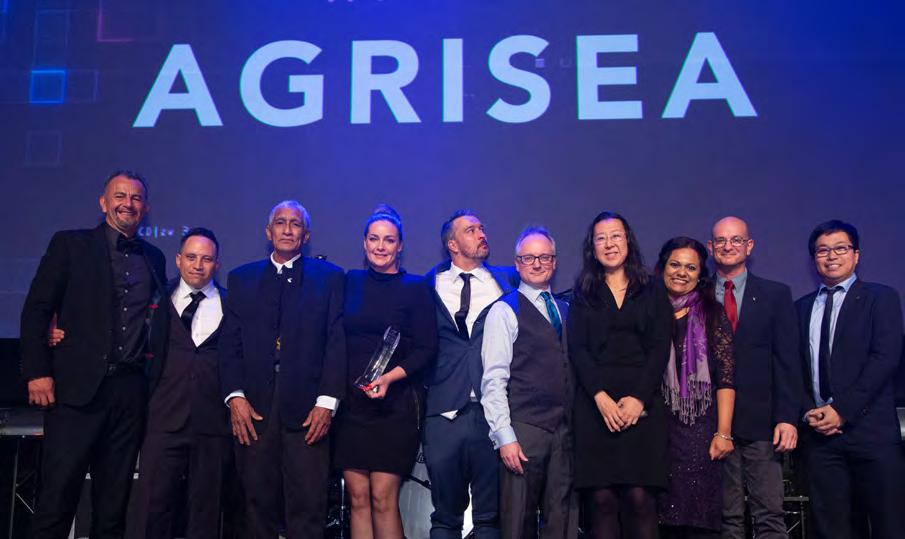
in establishing markets in Aotearoa and offshore – and as it expands by exploring different uses of seaweed for everything from wound care to creating cleaner waterways.
“We’re extremely humbled by the award,” says Clare, who is AgriSea’s Chief Executive Officer.
“It was an honour to be a finalist in this category for the second time in the row, so to win was really icing on the cake,” says Bradley.
“This win not only shows that green technology, using natural systems and ecological principles can be recognised as hi-tech but also how integrating manaakitanga and your values into work practices can have a
positive impact.”
The company tapped into the support of innovation agency Callaghan Innovation and New Zealand Trade and Enterprise, which has helped in establishing its markets in New Zealand and offshore.
“It’s been an incredible journey since we met the Scion crew at a Matariki X event hosted by Callaghan Innovation five years ago, which was where it all started to kick off for us,” says Tane.
This led to a partnership spanning the past five years developing products from the waste product of their biostimulants.
“Clare and Tane have been a
pleasure to partner with from day one, buying into our vision for what could be achieved by mechanically processing their seaweed to extract nanocellulose, which is then used to make hydrogels,” says Dr Stephan Hill, Portfolio Leader for High-Value Biorefineries at Scion.
The company has kept its operations in Paeroa and sell through Fonterra Farm Source stores in New Zealand.
Recently the business won a Fielday’s Innovation award for Fortress +, a newly released product formulation that when fed to cows reduces their oxidative stress (increasing disease resistance), as well as urinary nitrogen
levels by around 18 per cent.
“The science behind the formulation was developed over three years by a Lincoln University PhD student Matthew Beck, enabled by a Callaghan Innovation R&D Fellowship Grant,” says Clare. “From that threeyear journey we’ve produced seven peer-reviewed papers, and we’ve also had huge interest in the formulation from large markets, such as the US.” AgriSea secured a further Fellowship Grant to help it commercialise IP that it developed in partnership with Scion to develop high value hydrogels.
“Driving us forward has been our aligned values and vision,” says Clare. “Scion was clear that they wanted to do the best science, and we were clear that we wanted to bring innovative and green technology to the market.
The couple say Manaakitanga is an important value at AgriSea, which has grown a reputation for welcoming visitors from around the world.
“Sometimes it’s hard to encapsulate our approach to business,” says Tane, “but really, it’s that we live our values – to respect each other, and our environment. We see ourselves as a family doing good things and we want to partner with others who are doing the same.”
“We’ve always felt like we were on the cusp of something – it’s just that sometimes it takes a little longer than you envisage,” Clare says. “What we haven’t done is waited for the wave to come to us. We’ve invested in people, technology and partnerships to ensure we’re solving problems, and having a positive impact.”
The award was sponsored by Callaghan Innovation.
Leaders of the future give back to community
Twenty migrant and refugee families settling in Hamilton were gifted bikes as part of a Leadership programme run by the University of Waikato’s Management School.
Around 80 Year 13 students from across Waikato and Bay of Plenty came together on Tuesday for the Waikato Management School (WMS) Leadership Academy Summit Day. They heard about leading with compassion and empathy from celebrity speakers Mike King and Richie Barnett and spoke about personal self-assessment.

Charla Dougal of Mount Maunganui College, says she chooses not to wear her blazer at school because she wants to be approachable and relatable.
A surprise bike-building activity also taught students about the importance of working together, while giving back to the community.
Students grouped together to build 20 children’s bikes, donated by The Perry Charitable Trust and heavily discounted by Torpedo7.
The completed bikes were checked over by Torpedo7 mechanics to ensure they were roadworthy and ready to be presented to families at the Hamilton Multicultural Services Trust.
A family of 10 from Congo who arrived in New Zealand in February after spending 17 years in a Rwanda refugee camp said the bikes will help Ange, 10, and Joshua, 8, get to and from school.
Their brother Roger, 20, said they didn’t have bikes in Congo, “so we’re thankful and incredibly grateful for the bikes given to us.”
WMS launched the Leadership Academy pilot in Term One 2022 to support ambitious students to become stronger leaders.
For Charla Dougal of Mount Maunganui College, leadership became more than just a popularity contest.
“Take being a prefect, for example. You wear the jacket, you face the
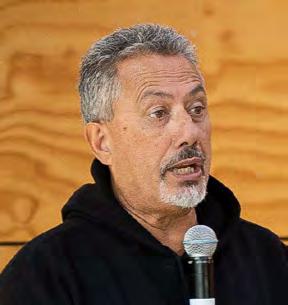
Mental health advocate Mike King told students being a good leader isn’t telling someone what to do, it’s showing them.
school and model what you think a leader is. But looking at it now, it’s way more than that,” Charla says.
“It’s about the little questions you ask. It’s what you do for yourself and the conversations you have with different people.”
Mental health advocate Mike King encouraged students with a passion to jump feet first.
“If you want to start a movement and be a good leader, have a passion and don’t leave your loved ones behind,” Mike says.
“Don’t test the water with one toe. If you’re passionate about something
and you have an idea of what you want to do, then just jump in.”
Former Kiwi rugby league captain Richie Barnett spoke about how his competitive attitude got him through one of the toughest moments in his professional career.
Richie had a full facial reconstruction following a smashing head clash during the 2000 Anzac Test. He suffered breaks to both cheekbones and his nose.
“I was in pain, people didn’t even recognise me. I was told my career was over but after seven months I got back on the field,” Richie told students.
“No matter what you’re going through, it’s how you deal with it.”
Stories like these solidified Anna Smith’s dream of becoming a surgeon.
“Caring for people is so important to me. I wish there were more people here to hear Mike and Richie speak so they could benefit from it too,” the Cambridge High School Head Girl says.
There were many lightbulb moments throughout the day. For Julie Brouwer of St Peter’s Cambridge, it was the realisation that leaders don’t have to be in a leadership position.
Julie says being turned down as a prefect was incredibly upsetting, but after being nominated by her school for the Leadership Academy she’s become a leader in her own way.
“I want to be a leader that motivates and inspires people,” Julie says.
“I used to think leaders had to be
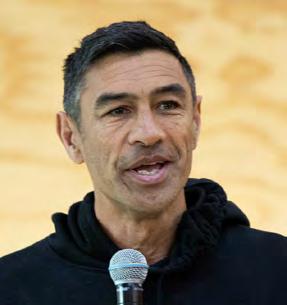
After a rugby injury that almost ended his professional career, Richie Barnett encouraged students never to give up.
direct and sometimes mean, but you can still treat people as people and you don’t need to be in a hierarchical position to be respected.”
Throughout the programme, students benefit from world-class leadership concepts and training from WMS staff and executive fellow and Alum Jamie Fitzgerald.
They also complete the WMS flagship first-year paper, Introduction to Leadership Communication, which means they will already have one paper if they go to university.
The pilot will conclude with a final hub day in Tauranga in September.
SHINING LIGHT ON THE POTENTIAL OF INDIGENOUS RESEARCH, SCIENCE AND INNOVATION
University of Waikato welcomes yesterday’s announcement of the government’s investment in Māori research, science and innovation and looks forward to being part of the path forward for indigenous leaders.
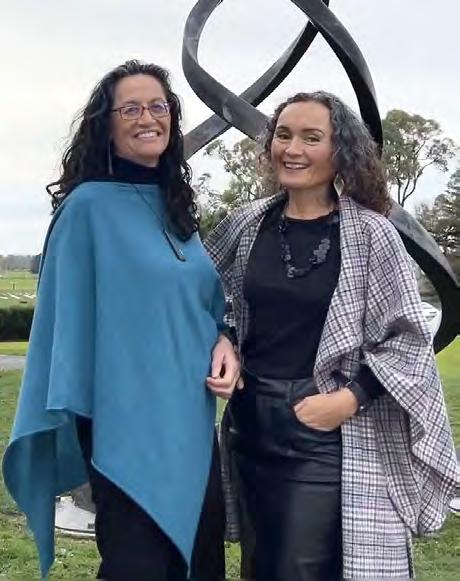
Pouhere Kanapu | Executive Director Vanessa Clark and Ngā Pae o te Māramatanga Pou Matarua | Co-Director Professor Tahu Kukutai alongsideAurei, a sculpture by WaikatoAlumnus Rangi Kipa at University of Waikato’s Kirikiriroa campus.
anapu is a new Māoriled initiative led by Ngā Pae o te Māramatanga’s (NPM) Māori Centre of Research Excellence (CoRE) that aims to ignite Research, Science and Innovation (RSI) talent and leadership across Te Ao Māori. The government yesterday announced a $6.5 million investment in the system.
Located at the University of Waikato with Pouhere Kanapu, Executive Director Vanessa Clark (Waikato; Ngāti Tiipa, Ngāti Tahinga, Ngāti Āmaru) at the helm, Kanapu will look to create spaces to design and implement practical initiatives, resources and tools to ensure Māori have greater visibility and impact in the RSI system.
“I am humbled by the opportunity to embark on developing future pathways of, by, with and for Māori,” Vanessa says. “This is very timely given the system reset with Te Ara Paerangi Future Pathways, which will bring Maori voices into focus.”
“The project brings together our aspirations with the opportunity to innovate in a Māori way.”
Māori researchers, scientists and knowledge-holders are fundamental to a vibrant RSI system but the evidence shows they are largely undervalued and unsupported. Kanapu – which means lightning or instantaneous glow – will strike at the obstacles that block Māori pathways in the RSI system.
First on the scene
The Tauranga Business Chamber’s August Business After 5 (BA5) networking event was hosted by the University of Waikato, Tauranga Campus. Guest mingled over drinks and nibbles, checked out the stunning architecture, and learned about the importance of the University’s presence in Tauranga.
Photography: Salina Galvan

1 6 7 4 8 9 2 3 10 5 K
“Ngā Pae is excited to be taking this next step to building the foundations for flourishing Māori futures. There are huge untapped RSI opportunities for our communities. Kanapu will help
realise them”, ” says Ngā Pae Pou Matarua | Co-Director Professor Tahu Kukutai.
Over six years Kanapu will work with Māori researchers, scientists and knowledge-holders to design bespoke initiatives to meet the programme’s goals to:
● strengthen connections between the RSI system and hapū, iwi, and Māori communities
● support Māori scientists, researchers and knowledge-holders to thrive as Māori within the RSI system
● provide opportunities for Māori scientists, researchers, and knowledge-holders to access the right resources and supports to develop their talent and leadership skills
● leverage and develop customized tools and resources to support RSI system navigation Research, Science and Innovation Minister Dr Ayesha Verrall has underscored the importance of excellent research for and with Māori, iwi and hapū.
“Growing a research workforce where the skills, perspectives and expertise of Māori are well represented is a key part of ensuring we have a thriving and talented workforce to meet the opportunities and challenges of today and the future,” Dr Ayesha Verrall says.
“Kanapu is a further way the Government is strengthening the benefits that Māori knowledge, culture, values and worldview bring to the research system. This initiative will enhance employment outcomes of Māori in the research workforce and will benefit the whole research workforce.”

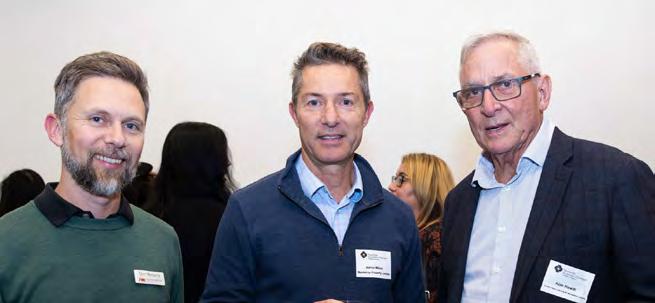
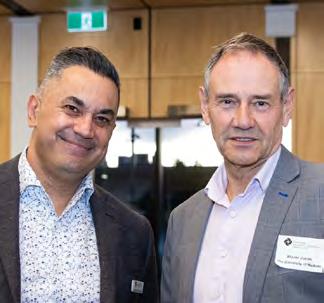



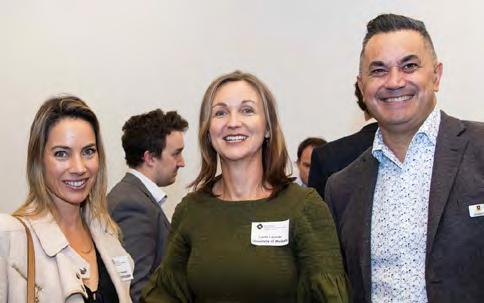
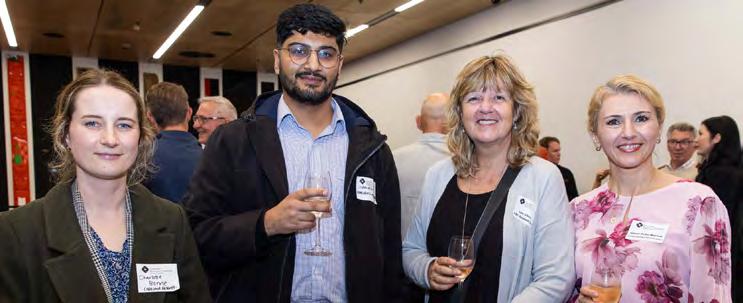
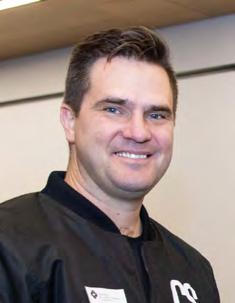
9 Charlotte Borrie (Copeland Ashcroft Law), Manveer Bassan (Copeland Ashcroft Law), Lisa Gilmour (ABC Business Sales), Valerie Rowe-Mitchell (Emerald Business Advisors Ltd). 10 Iain Chapman (CS Signhouse).
1 Sam Sleigh (The Firm (Tauranga) Ltd). 2 Peter McKinlay (Mckinlay Douglas Ltd), Tania Crowe (Stratum Consultants), Graeme Wilson (Wilson Logistic Services), Kathrin Chappell (Lavish Food Events).
3 Tom Beswick (Ingham Mora), Aaron Milne (Mackersy Property Ltd), Alan Hewitt (Apricity Finance). 4 Joseph Macfarlane (University of Waikato), Alister Jones (University of Waikato).
5 Holly Parata (Bishopp Airport Advertising), Kylie Frank (Kiwi Commercial Cleaning), Marie Roberts (Kanuka Wellbeing and Leadership), Tony Cray (GHD Limited). 6 Tom Beswick (Ingham Mora).
7 Conrad Kuriger (Kuriger Builders Tauranga), Steve Smith (EmbroidMe Tauranga), Robyn Kuriger (Kuriger Builders Tauranga). 8 Louise Chapman (CS Signhouse), Linda Lipinski (University of Waikato), Joseph Macfarlane (University of Waikato).
NEW APPOINTMENTS
BBN’S GUIDE TO NEW PEOPLE AND NEW ROLES ACROSS BUSINESS IN THE BAY
To feature in New Appointments email us at new.appointments@bopbusinessnews.co.nz
Bonnie Pitchford
Sharp Tudhope Lawyers are delighted to announce the promotion of Bonnie Pitchford to Senior Solicitor. Bonnie has established herself as an integral part of our property team and strives to consider clients’ longterm interests and the effects of today’s decisions upon tomorrow’s outcomes. Partner, Hamish Murray says, “Bonnie has shown a real talent for networking and her dedication to Sharp Tudhope, her work and her clients is obvious. This is a well-deserved promotion and we look forward to supporting her continued growth.”

Darcy Simonis
Tauranga-based Agri-tech company, Bluelab has announced the appointment of Darcy Simonis as Chief Revenue Officer. Darcy brings more than two decades of extensive global experience in B2B and B2C sales,
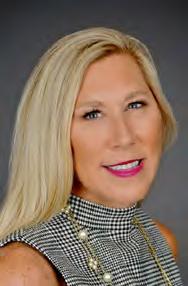
sales operations, and marketing. With proven success steering vision, strategy expansion, and revenue for instrumentation companies like ABB and Pentair, Darcy will help to ignite the team to maximise performance and deliver on ambitious goals. Her experience in the food and beverage industry gives a unique perspective on the challenges of food production, which has a natural alignment with the company’s business purpose: The Art of Growing for a Healthier World.
Gareth Brown and Matthew Laing
First Mortgage Managers Limited (FMML), manager of First Mortgage Trust (FMT), has appointed Gareth Brown as the new Head of Treasury and Matthew Laing as Wholesale Investment Manager.

Gareth is highly experienced in treasury management having previously been the Head of Financial Markets and Treasury Risk at a major bank. He also spent two years in treasury and risk management with an accountancy and advisory business. Recently Gareth has been operating his own advisory company providing financial market and treasury advice to banks which included advising on ESG processes.
Matthew Laing joins the investment team
in Auckland as Wholesale Investment Manager. Matthew has extensive experience and knowledge in the investment and financial industry.
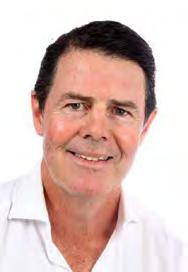

Paul Bendall, CEO, says, “These appointments reflect our desire to expand our funding footprint on a national basis. As an active fund manager, First Mortgage Trust is constantly reviewing the NZ market to ensure we optimise our investors’ returns on their investments. The introduction of these two roles will ensure we continue to provide our investors a great customer experience and good outcomes, which remain at the heart for what First Mortgage Trust has done for the last 26 years.”
Jono Jones
September marks a new chapter for Bluelab. After 22 years, Greg Jarvis has announced he’s stepping aside as CEO, and announced Jono Jones as the new CEO. His clarity of purpose, vision and ambition for Bluelab’s future

Mark Mcilroy

Transport Works Group New Zealand is happy to announce Mark Mcilroy as the newest director of the business alongside Danyul Gleeson. Mark has been the GM of New Zealand for the past 18 months and will continue this role as well as taking on the director responsibilities. Mark has a passion for the freight industry and helping Transport Works current and potential clients gain efficiencies and savings through the use of technology and continuous improvement strategies.
Transport Works Group covers all aspects of the supply chain in domestic and international freight covering ambient, temperature controlled and warehousing. The company has an ‘on the ground’ presence in New Zealand, Australia and the USA.
While you roam in Australia, 2degrees fights for fair in New Zealand
Business travel is back, with the volume of travellers roaming in New Zealand finally back to pre-lockdown levels, according to 2degrees.
“In August we recorded almost 100,000 overseas devices roaming in New Zealand – that’s very similar to the peaks we saw in 2019,” says 2degrees Chief Business Officer Andrew Fairgray.
Fairgray also notes that more Kiwis are back travelling – with data showing Australia to be the most popular destination.
He says much has changed in the roaming space since 2020 as well, and that two things for business travellers to look for are eSIM capabilities and special roaming rates.
eSIMs enable services on modern phones and devices without the need for a physical SIM card.
“The real benefit to users is that they can have two SIMs active on a single phone. This is ideal for those who currently juggle a work and personal mobile, want to use a local SIM while roaming overseas, or have a backup services on their phone. Now they can use a single phone and virtually switch between SIMs,” Fairgray says.
2degrees has made using your NZ mobile plan while roaming in Australia free on all business mobile plans and you can also use your plan for $8 a day while roaming in over 100 popular destinations.
Fairgray says free roaming to New Zealand’s biggest trading partner ‘just makes sense’.
“For too long, business travel has come with an additional hassle relating to phones and connectivity. It hasn’t been a question of people not being able to afford roaming charges, it’s more a case of feeling like you’re being ripped off.
“The fact is, when you don’t have to worry about your phone bill, you’re going to use it more. It is about convenience and accessibility. And of course, better communications with no hesitation,” Fairgray adds.
2degrees launched free roaming in late 2019. “We pretty much launched at the worse possible time for business travel. But, it was a great idea then, and is a great idea now.”
The 2degrees solution is simple: it covers the cost as a way of helping people working in Australia.
“Ultimately as a company 2degrees covers the roaming costs, and we are happy to. We have a company purpose to ‘Fight for Fair’, and enabling Kiwi businesses to grow and thrive really fits the bill. We are here to increase competition and challenge, and we believe doing so positively impacts ‘NZ Inc’.”
As a maturing challenger brand, Fairgray says 2degrees today has come a long way from its humble beginnings as the country’s 3rd
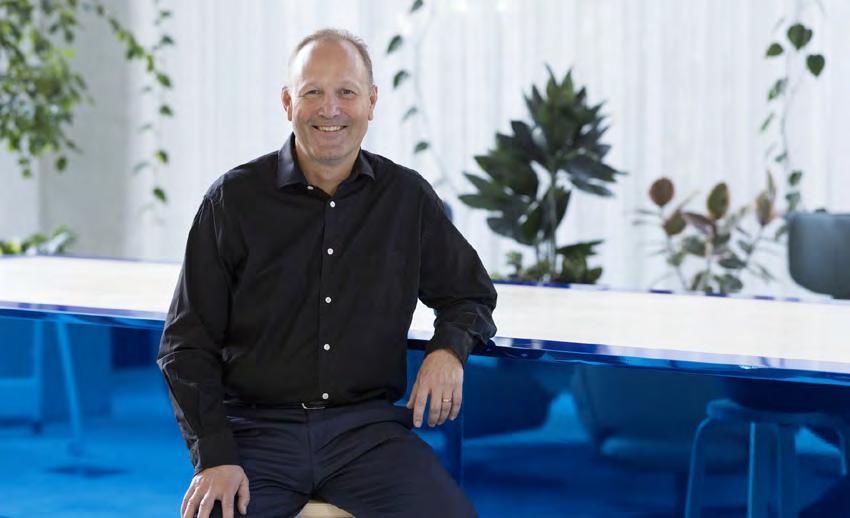
mobile operator back in 2009.
“The deck is stacked against late entrants, but 2degrees has established itself as a contender not only by making investments in network capacity and capability, but also consistently fighting for the rights of the consumer.
“When you have a monopoly or a duopoly, prices stay stubbornly high while innovation falls on the backburner. We’ve upended the market, making communication more affordable and more accessible.
And that includes when you’re in Australia.”
He says NZ Inc can enjoy confidence in 2degrees, too. Today, the telecoms operator’s ‘vital statistics’ reveal a company that has delivered impressive growth.
With revenues of $1.2 billion, 345,000 fixed and 1.5 million mobile customers, a mobile network of 1800 sites covering 98.5% of where Kiwis live and work and 4,600 kilometres of fibre in the ground, 2degrees has the scale
to serve business and consumer customers wherever they are locally.
“And with roaming on Australian 4G networks including Optus and Telstra, 2degrees works just as well for you on the other side of the Tasman, too.”
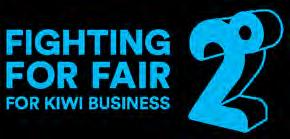
Andrew Fairgray,Chief Business Officer,2degrees
as Chief Product and Innovation Officer. In this role, Jono drove Bluelab’s growth and strategic direction with his unique insights and customer empathy.
Gareth Brown
Matthew Laing
RUNNING A SMALL BUSINESS IS PART OF OUR NATION’S DNA
New platform launches to help small Kiwi businesses thrive.
Anew support service is here to help Kiwi business owners get the tools and support they need to thrive. Small Business NZ (SBNZ) is an online platform that launched in August, aiming to provide community, connection and resources for small and micro businesses across the country.
Because, let’s face it, running a business is hard. Often small business owners feel isolated, left trying to figure it all out alone.
Despite the difficulties, New Zealand is a proud nation of small and micro business owners. Defined as a business with fewer than 20 employees, there are approximately 530,000 small businesses in Aotearoa, according to Statistics New Zealand and the Ministry of Business, Innovation and Employment. This means small businesses make up 97% of all companies in New Zealand, contributing to over a quarter of New Zealand’s GDP and accounting for 28% of nationwide employment.
SBNZ founder and spokesperson Philip Wicks says that in his work as a business success coach, he encounters common problems – feelings of overwhelm and isolation, as well as not knowing where to look for quality assistance. He hopes the platform will help hard-working Kiwis across the country by providing access to quality resources and a support network.
“We want to help small business owners achieve greater work-life balance and business success, equalling a lot less stress. SBNZ aims to save Kiwi business owners time, no more searching on Google, by providing one central hub full of quality resources, articles, and templates suitable for running a business in New Zealand.
“The other idea behind founding this platform is there will be a nationwide network where business owners can ask questions, receive quality support and advice, and ultimately help them feel supported in the hard work of running a small business.”
Wicks says the platform will also provide members with access to a nationwide network of fellow small businesses, as well as expert providers who have been thoroughly vetted. Small business owners that sign up as SBNZ members by paying a small annual subscription will receive access to discounted services by expert providers in various fields, accounting, business coaching, etc. The site will continually feature more features and resources as it grows.
“There are so many hats that a small business owner wears – marketing, accounting, operations, strategy, customer service, human resources, to name a few.
“We want to help small business owners learn which hats they should wear and consider which roles they could possibly outsource at minimal cost.”
All members who join SBNZ before the 1st of October will be eligible to receive a complimentary 60 Point Business Diagnostic and report (valued at $1200), courtesy of sponsors BSP Advisory Group. In addition, 10% of annual membership fees go towards funding advisory and support assistance for small businesses.
Small Business NZ is founded by business coach Philip Wicks, with sponsorship support from Adeption; Accountants & Tax Agents Institute of NZ (ATAINZ); BSP Advisory Group; Cultivating Leadership, and MAUS Business Systems.
To find out more, visit sbnz.co.nz
Cash or Credit?

When I left the hardware store on Saturday – I won’t mention which one, suffice to say the same stage setting seems to apply, whichever chain I visit – the sizzling onions beckoned me. I can ‘take or leave’ the sausages, but the onions get me every time.
“Eftpos?”
“Not a problem, Sir.”
Fast forward 10 minutes and 400 metres to the raffle tickets at the supermarket – well, that was an entirely different cup-of-tea.
They needed cash.
I don’t do cash.
I explained that I don’t do cash.
They didn’t believe me.
I felt like a heel, literally falling over my feet, all the while not breaking stride but explaining at-length, while yelling back over my shoulder, that, “I don’t carry cash”.
Although I could feel my voice tapering-out as I disappeared into the third
HAVE YOU EVER NOTICED?
> BY ALAN NEBEN
Alan Neben is a Mount Maunganui local and experienced New Zealand Publisher. He supports various local community initiatives and encourages you to do likewise.
aisle of the carpark, I felt as if the raffle-ticket people still had ‘unfinished-business’ with me.
They didn’t believe me. I know they didn’t. I could feel they didn’t.
The guilt turned to anger.
“They shouldn’t expect people to have cash – its 2022; The Girl-Guides new rescue helicopter playground fundraising parents should damn well know that.”
By way of illustration, a quick quiz: What coins are currently in use as legal tender in New Zealand? I don’t mean the $1 and $2 ‘goldies’ – even I know they’re still around. But what about the one cent, two cent, five cent, 10 cent, 20 cent and 50 cent coins? Do they even exist anymore? And, unless you work in the Two-Dollar Shop, or serve at the counter of the tea-rooms my grandmother still visits, do you even know what those coins look like now
– if they do still exist?
I had to drive the long way out of the carpark so I didn’t have to make eye contact with the raffle people.

I usually feel good driving my new car – now I felt doubly-guilty: “So you can afford a new car (and six bags of August 2022-priced groceries, including the posh IPA craft beer), but you can’t spare a couple of bucks for the disabled pets horse-riding program? You lousy flash new car driver!”
I’m sure life used to be easier before the inconvenience of cashless convenience.
I suspect I’m not alone in my subsequent self-flagellation – how dare the local kindergarten ruin my feel-good Saturday shopping trip.
At least in the old days if I was home and the guys with the bikes and short-haircuts knocked on the door I could pretend I
wasn’t there – a quick thirty second drop and roll by the lounge window and, ‘Bob’s your Aunty’, another sermon and ‘please just leave donation’ bullet dodged. But ambushed at the supermarket door, there’s simply nowhere to hide –it’s you against the Under-8 netball team mums – and they can hurt you real bad with just a look.
My advice: keep a twenty dollar note on your person at all times – and keep a reserve one in the car. Don’t be tempted to use it for anything other than bona fide raffle ticket emergencies.
Guilt got the better of me. I eventually went back to the supermarket with $20 cash. To get the cash I had illegally parked so I could use an ATM. Upon return-
ing from the ATM to my car I had a parking ticket. $40. One non-descript piece of text in the small print on the reverse side of the infringement notice mockingly caught my eye – ‘INFRINGEMENT FEES CANNOT BE PAID IN CASH’.
Postscript: I now have a ticket and I’m in the draw to win a trailer, or perhaps a heat-pump. The local community hip-hop orphans dance crew (and their parents) are well on their way to being able to afford that luxury vacation (and dance competition) in Hawaii, and I can once again go back to the supermarket, guilt-free – but now always with a twenty in my back pocket.
Time to spring into action
Ah, spring time – who doesn’t love a good spring clean? Having a good clean out and refresh doesn’t need to be limited to your home; it is also a great time to apply the same principles to your business, and in particular the human resource side of your business.
Most of us have good intentions when it comes to our businesses, however when we get busy, pressured and stressed, some of the housekeeping tends to get overlooked. Spring is a great time to do a bit of a WOF on your business and ensure it is set and ready for the busy summer months ahead.
Ensuring your HR systems and procedures are in place, relevant and current will set your business up well. This ensures you have a solid platform for growth, enabling your business to focus on the bigger issues.
Spring is a good time to look at the basics – ask yourself, do you have up to date position descriptions, employment agreements and house rules?
How relevant and up to date are your policies and procedures, or do they need a refresh? Have you kept accurate and up to date staff files or do these need a refresh too?
Have you made time to sit with your staff, have a conversation about the roles they are doing and get
their feedback, leading into a more formal review process if you do these?
This could also lead into looking at individual staff and team targets, and talking with your staff individually, and as a team, to chat to them about where they are at with their personal and team goals.
Do you ever ask your staff for feedback on their position, the team and the company?
Feedback should be welcomed. The good, the bad and the ugly. It may be a vital key to the culture and productivity within your business. As business owners and leaders, we also need to hear about areas that we too can improve, so don’t overlook the value and shy away from this type of feedback.


HUMAN RESOURCES
> BY KELLIE HAMLETT
Talent ID are Recruitment Specialists and can support you through your recruitment process. Please feel free to talk to us about this by calling 07 349 1081 or emailing kellie@talentid.co.nz
Knowing where your staff and team are at, and how they are working together can help you build a more cohesive work environment for the future, which will ultimately be more productive and profitable. This may also be a good time to consider a health and wellness survey which may lead to implementation of a wellness programme.
Having your human resource framework current will make it easier to manage your staff now and in the longer term as well as enable you to focus on the bigger picture.
Every so often we come across businesses who have grown quickly but struggled to keep up with the basic processes and requirements for managing their staff.
This can often lead to staff dissatisfaction down the track, hinder growth, as well as raising compliance issues.
So, this Spring, give your human resource system a warrant of fitness, so that you can focus on the busy summer months ahead, growing your business, maximising profit and maybe even squeezing in a summer break.
LEASE & INVESTMENT OPPORTUNITIES

70
80 % % Leased
Leased | Sold Set
Exciting new mixed use development in the heart of Omokoroa. The Village will provide much needed amenity with a mix of retail, hospitality, wellness and office tenants.

Brand new commercial development at Papamoa Junction. Spring Papamoa is 80% leased / sold, with a mix of high calibre medical tenants.
For leasing and investment opportunities contact: Andrew Vincent – Development Manager 021 059 8365 | andrewv@fosters.co.nz
The Foster Group operates with a purpose of building ‘great communities through strong foundations’. We’ve made a significant contribution to our build environment since 1948 when LG Foster started business. We continue to build on our legacy through meaningful contribution, purposeful business, community relationships and sustainable practices – always striving for the highest standards to be best in our market.
THE VILLAGE OMOKOROA
SPRING PAPAMOA
